Ready to embark on an unforgettable motorhome or campervan adventure in Portugal?
Portugal, the country that gave birth to Vasco de Gama and Christiano Ronaldo, isn’t just the homeland of explorers and football legends; it’s a mosaic of experiences waiting to be discovered.
Campervanning in Portugal will have you weaving through landscapes dotted with azulejo tiles, savouring the freshness of grilled sardines, and sipping on the sweet notes of port wine.
As seasoned travellers who have explored 22 countries throughout Europe in a motorhome, ventured across southern Africa in a 4×4 with a rooftop tent and embraced the life of full-time nomads with 4x4s in both Australia and Botswana, our expertise in campervanning and overland travel is deeply rooted in diverse, real-world experiences.
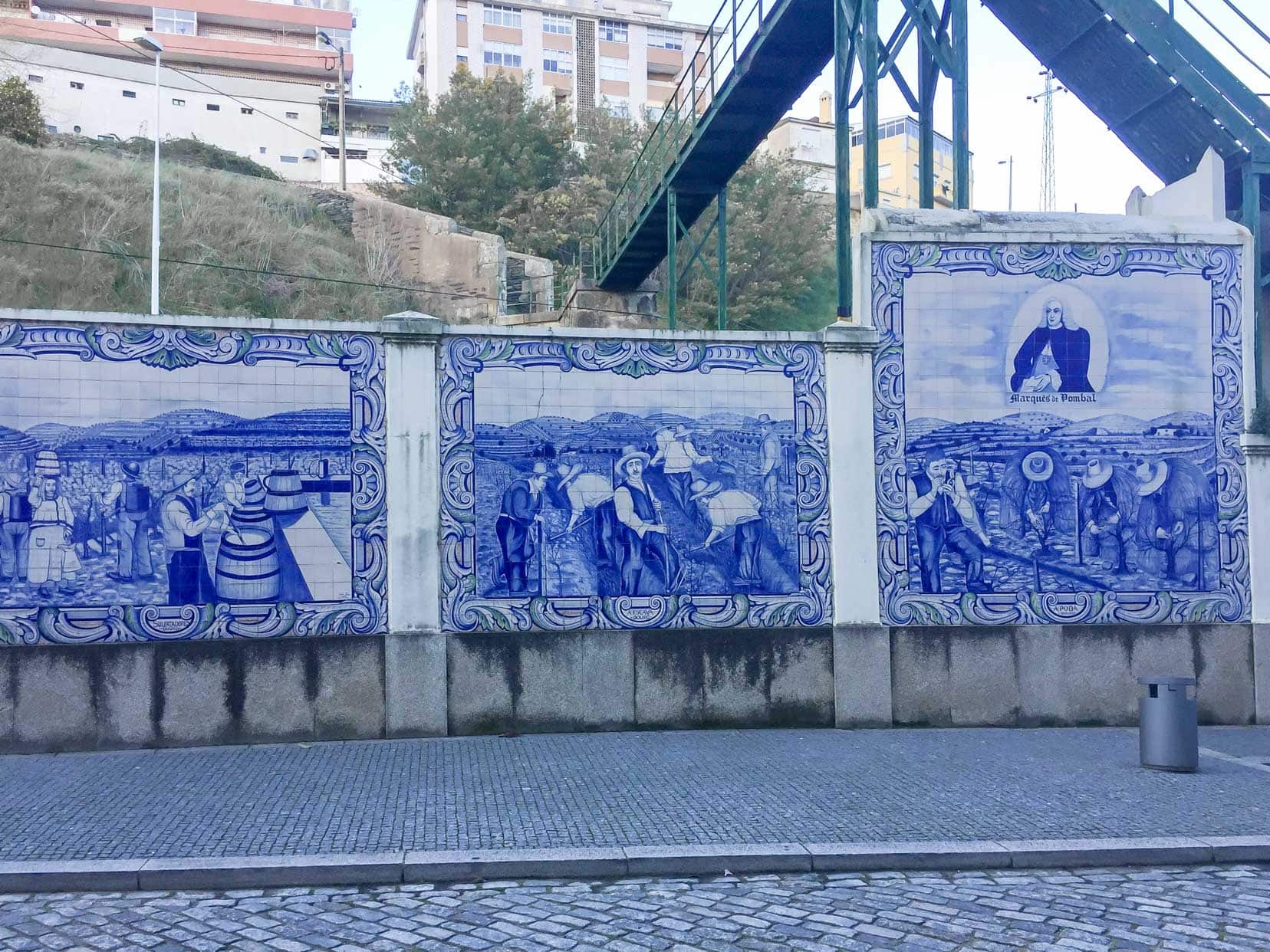
We’ve navigated these routes ourselves, uncovering hidden gems and gathering practical tips for your campervanning and motorhome trip in Portugal. From the lively streets of Porto to the tranquil Douro Valley, Portugal unfolds its beauty at every turn.
And as you uncork another bottle of its finest port, remember Portugal is not just a place to visit; it’s an experience to be lived, savoured, and cherished.
🥜 In a Nutshell: Places to Visit While Touring Portugal in a Motorhome or Campervan
Here is a summary of places to visit while campervanning and motorhoming in Portugal. We cover these in more detail later in the post.

What’s Included in this Motorhoming Portugal Guide?
We’ve dug deep to bring you this comprehensive information to help you plan your Portugal campervanning road trip. Navigate directly by clicking the link below:
- 🗺️ Interactive Journey Map: Visualize and plan your route with our detailed, interactive map.
- 🏕️ Campsite Recommendations: The best spots for a comfortable stay in your motorhome.
- 🛑 Local Motorhome Rules: Key information on regulations, overnight parking and wild camping.
- 🚙 Motorhome and Campervan Rental in Portugal: Getting the best deal for your dollar.
- 👀 Must-Visit Destinations: Uncover hidden gems and iconic spots perfect for motorhome explorers.
- 🛣️ Driving Tips: Navigate Portugal’s roads safely and confidently with our insider advice.
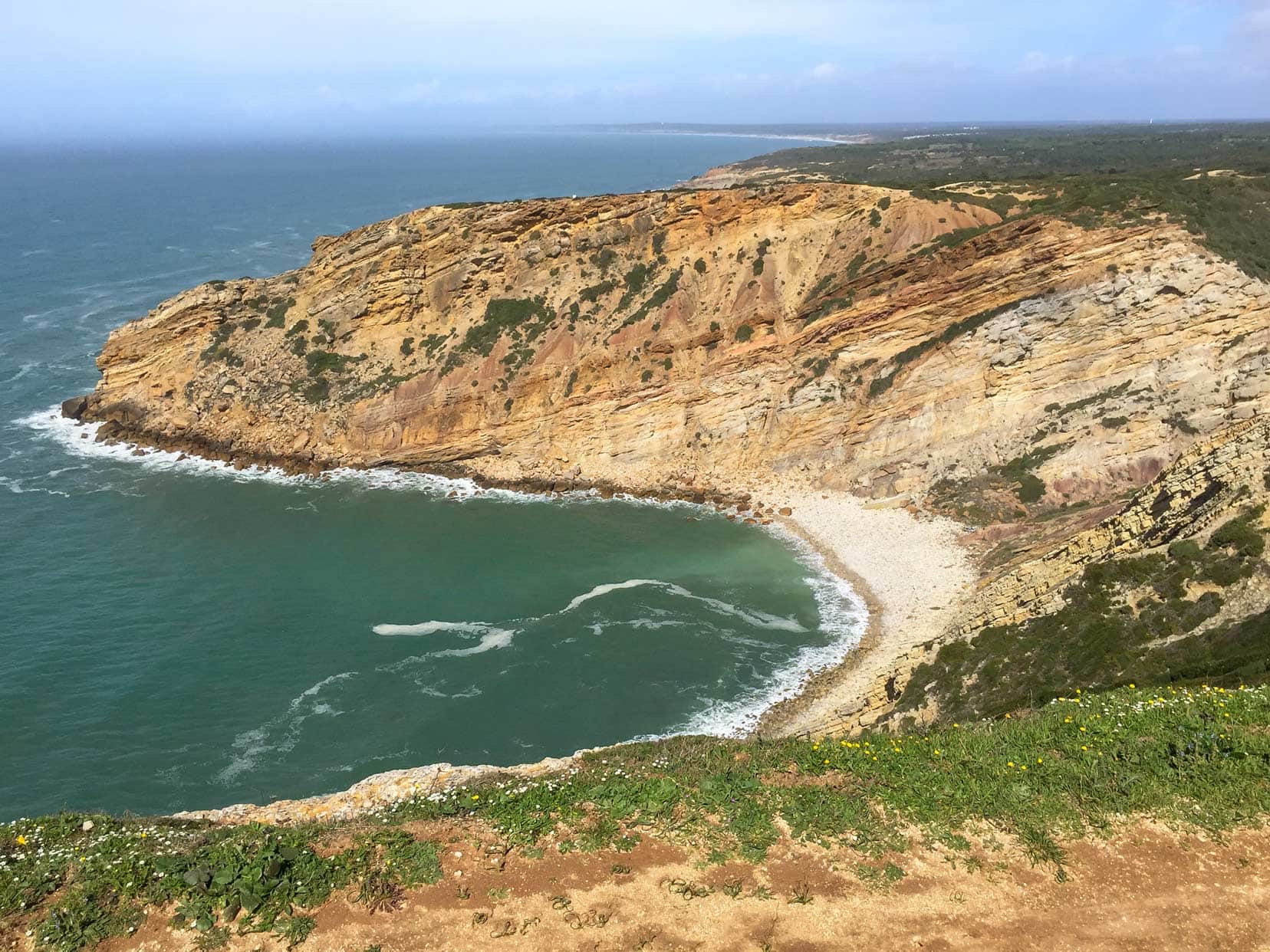
📖 READ MORE: If you are new to campervanning and motorhoming, these road trip articles will help build your knowledge and confidence to hit the road.
Map: Campervanning and Motorhoming in Portugal
How to Use This Portugal Route Map
To use this map, expand it using the square symbol at the top right-hand side. The key is on the left-hand side. By clicking each location, you will find extra information.
For example, each campervan/ motorhome/RV overnight park on the Map has the web link to Camper Contact to see the facilities available, price, opening times, and useful user reviews on each campsite.
🔵 For our motorhome route through Portugal, click the box labelled Our Motorhome route. You can also unclick it to see a clearer picture of the places visited.
🟤 The motorhome overnight stops we used are marked with a brown circle and a motorhome icon.
🟣 The places we visited are marked with purple icons.
🟡 The yellow icons are the Paiva Walkways in Arouca and the longest suspension Bridge in the world – 516 Arouca
Route Planning: Campervanning and Motorhome Portugal
Embark on a journey through Portugal, a country brimming with diverse experiences within its modest 220km width and 560km length.
Our two-week adventure exploring Portugal by campervan in mid-March was a revelation, although rainy and chilly for much of it. Each day brought its unique charm.
Consider our carefully curated route (see map above) as a template for your adventure, including popular destinations and off-the-beaten-path gems.
The true joy of campervanning lies in its flexibility. So, remember to leave room for spontaneity. It’s the heart of adventure. For instance, on a local’s tip, we discovered a quaint chapel on the coastal path at Cabo Espichel – a wild spot missed by most tourists.
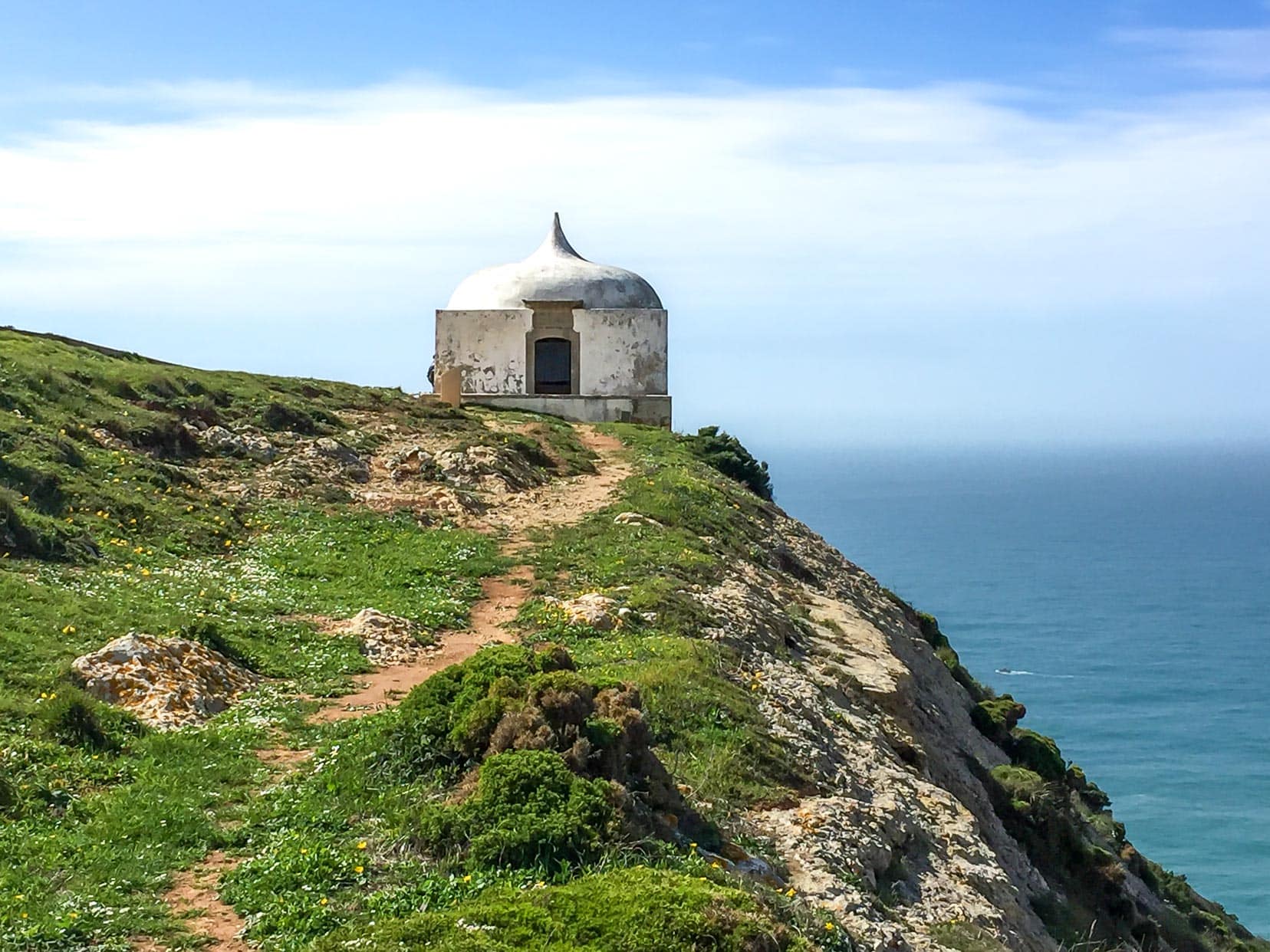
As you draft your route, make space for serendipity. Portugal is full of surprises, from impromptu village festivals to breathtaking scenic detours, which often turn into the most treasured experiences of your journey.
🌎 Enhance your Portugal road trip with our FREE printable road trip planner. Developed from our on-the-road experiences, this planner is a treasure trove of insights, ensuring a seamless and enriching travel experience.
Remember, high seasons in July and August can get busy in Portugal’s main cities and the Algarve region. Also, the year is peppered with festivals and events, so check out Portugal’s official events calendar to plan accordingly.
Plan Your Travels to Portugal?
- 🏥 Travel insurance: We recommend World Nomads or Safetywing
- ✈️ Flights: Use Skyscanner for flight booking deals
- 🚘 Need to hire a car? We use and recommend DiscoverCars
- 🚐 Camper Hire: We recommend Motorhome Republic
- 🪪 Need an International Driver’s License? Order online here
- 🐕🦺 Pet Care: Use TrustedHousesitters and have an animal lover look after your pet for FREE (Use our Discount code: LIFEJOURNEY25 for 25% off)
VIDEO: Our Portugal in a Motorhome – two weeks in three minutes
Where to Camp when Motorhoming and Campervanning in Portugal?
We used the Camper Contact app (about 10 euros/year) to find our campervan overnight stops when we were travelling through Portugal. They have about 736 campervan parking and motorhome service areas listed throughout Portugal.
Portugal also has motorhome service areas throughout the country, many of which allow a maximum of a 72-hour stay. Some also have electricity, but most just have basic motorhome services.
You can find a list and a search tool at Camping-car Portugal here. ❗️Don’t set up your awning or use chairs outside your campervan in this type of service area.
Another option for overnight campervan stays is to use Portugal’s relatively new scheme, Portugal Easy Camp.
This is how it works:
- It is a three-step system; you choose your host, buy the welcome package, and then stay overnight (24-hour stay only).
- You need to arrive within office hours and must always have reserved your spot beforehand.
- Most hosts only have about two camp spots available.
- The welcome packages consist of artisanal products such as wine, olive oil, cheeses, and honey. For example, two bottles of wine for 18 euros.
Am I Allowed to Wild Camp in Portugal?
The rules about whether you can wild camp in Portugal have changed over the last few years, but at the latest check, as of the start of 2024, yes, you are allowed to wild camp in Portugal.
Every campervanner should be aware of the specific rules, though.
While the beauty of Portugal beckons you to explore its natural and coastal areas, motorhome stays are restricted in Natura 2000 Network areas (birds and habitat protection zones), protected zones, and coastal areas managed under specific plans. Exceptions exist to this, but they’re clearly marked.
Unless local municipal laws state otherwise, you can park your motorhome for up to 48 hours in the same municipality. Respecting these limits is essential to maintaining harmony with local communities and preserving Portugal’s natural beauty.
Remember, your adventure should leave no trace. Always be considerate of your noise levels and ensure you leave your camping spot just as pristine as you found it. This not only shows respect for the environment but also for the local community that’s hosting you.
Exploring Portugal in a motorhome is an adventure of a lifetime, but it’s crucial to do so responsibly. Remember these guidelines to ensure a memorable and respectful journey through this stunning country.
To help with your planning – we’ve included all our overnight stops for our campervanning in Portugal trip on the above map.
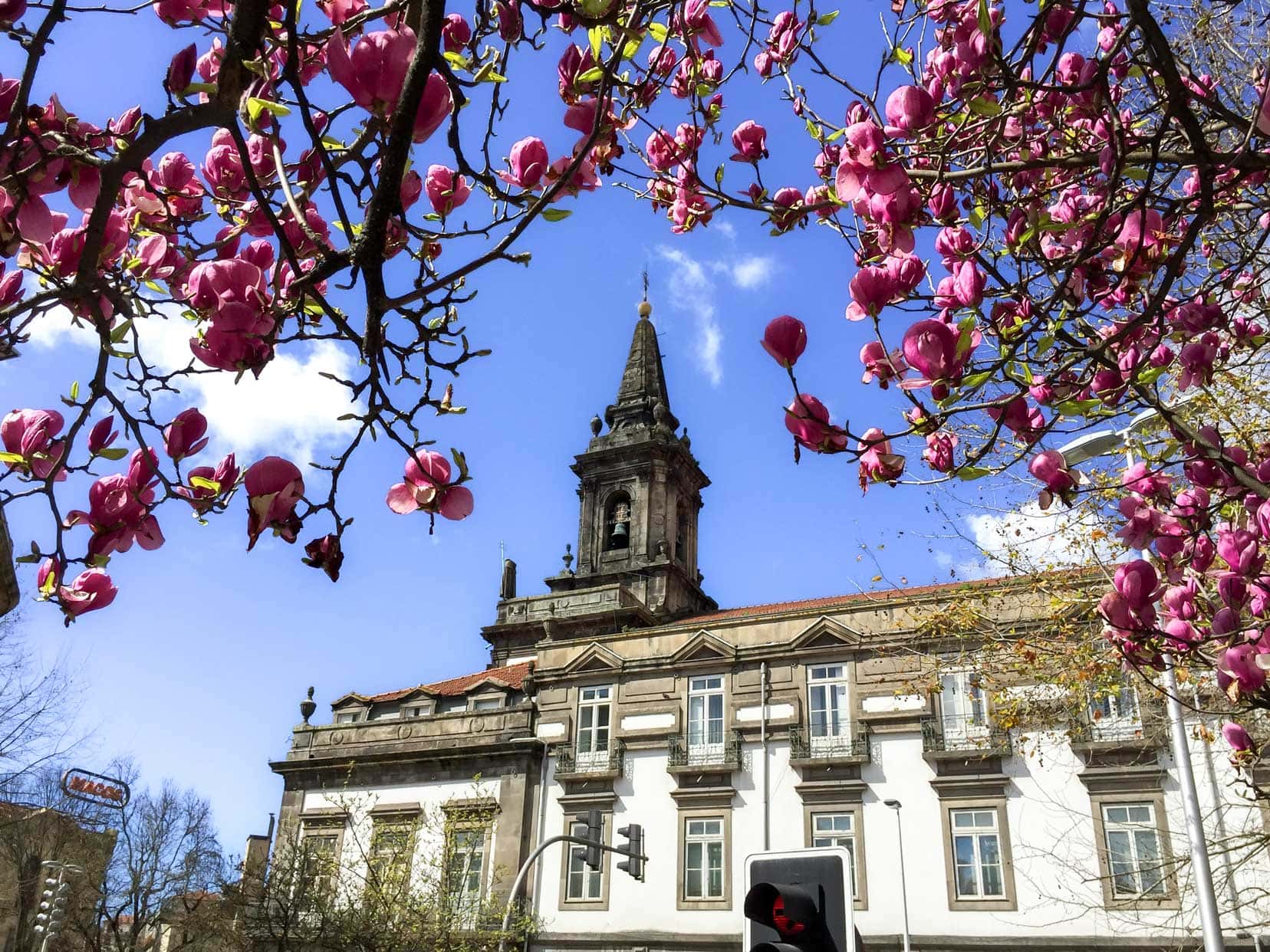
Motorhome and Campervan Rental in Portugal
If you don’t have your own motorhome and are looking to rent a campervan, we recommend the Motorhome Republic. They can search for the best deals for you and have various pick-up locations throughout Europe.
When we used them, they were incredibly helpful, and we saved more money going directly to them rather than to individual rental companies.
We’d recommend that you grab a quote from them for campervan hire in Portugal.
💡Our Tip: Motorhome and camper travel has really ramped up since the Covid pandemic. So, you’ll want to book ahead in plenty of time to ensure you can choose the right type of camper or motorhome for your Portuguese travels.
Top Places to Visit on Your Portugal Campervanning Trip
Embark on a journey through Portugal’s enchanting landscapes, where each stop is a treasure trove of unique charms and hidden gems.
From the sun-kissed beaches of the Algarve to the historic streets of Porto, let’s uncover the captivating spots that make your campervan adventure remarkable.
Let’s start at our first stop in Portugal, on the Algarve, Monte Gordo.
1. Monte Gordo
🚙 Motorhome / Campervan Stop: Monte Gordo Municipal Camper Park
Our first motorhome stop in Portugal was at a large (100+) campsite in Monte Gordo. Many of the camp’s residents looked like they had been parked up for a while, and although the facilities were quite basic, the location was great.

Just a few minutes’ walk from the campsite was Monte Gordo, one of the longest stretches of beach on the Algarve and one of Portugal’s safest beaches.
We were there in early March, so the beach wasn’t full of locals or tourists. I doubt you’d see the same empty beach vista in the summer!
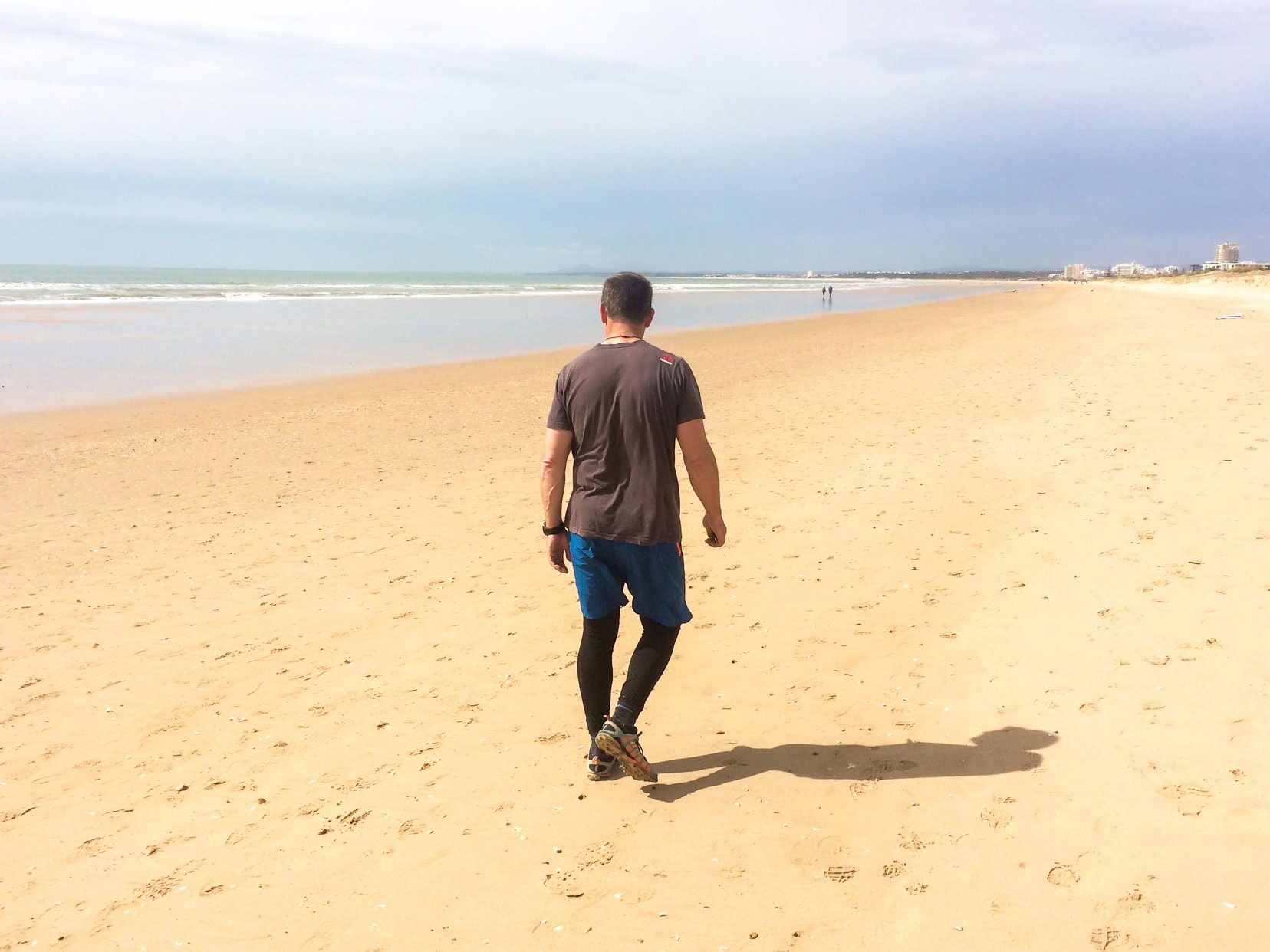
Our favourite discovery, however, was the nearby Mata Nacional das Dunas Litorais pine forest. Spanning 440 hectares, it was a serene retreat for us nature lovers.
We delved into the world of geocaching here, unearthing hidden treasures like a cleverly disguised pine cone cache and another in a sneaky birdbox, which was great fun.
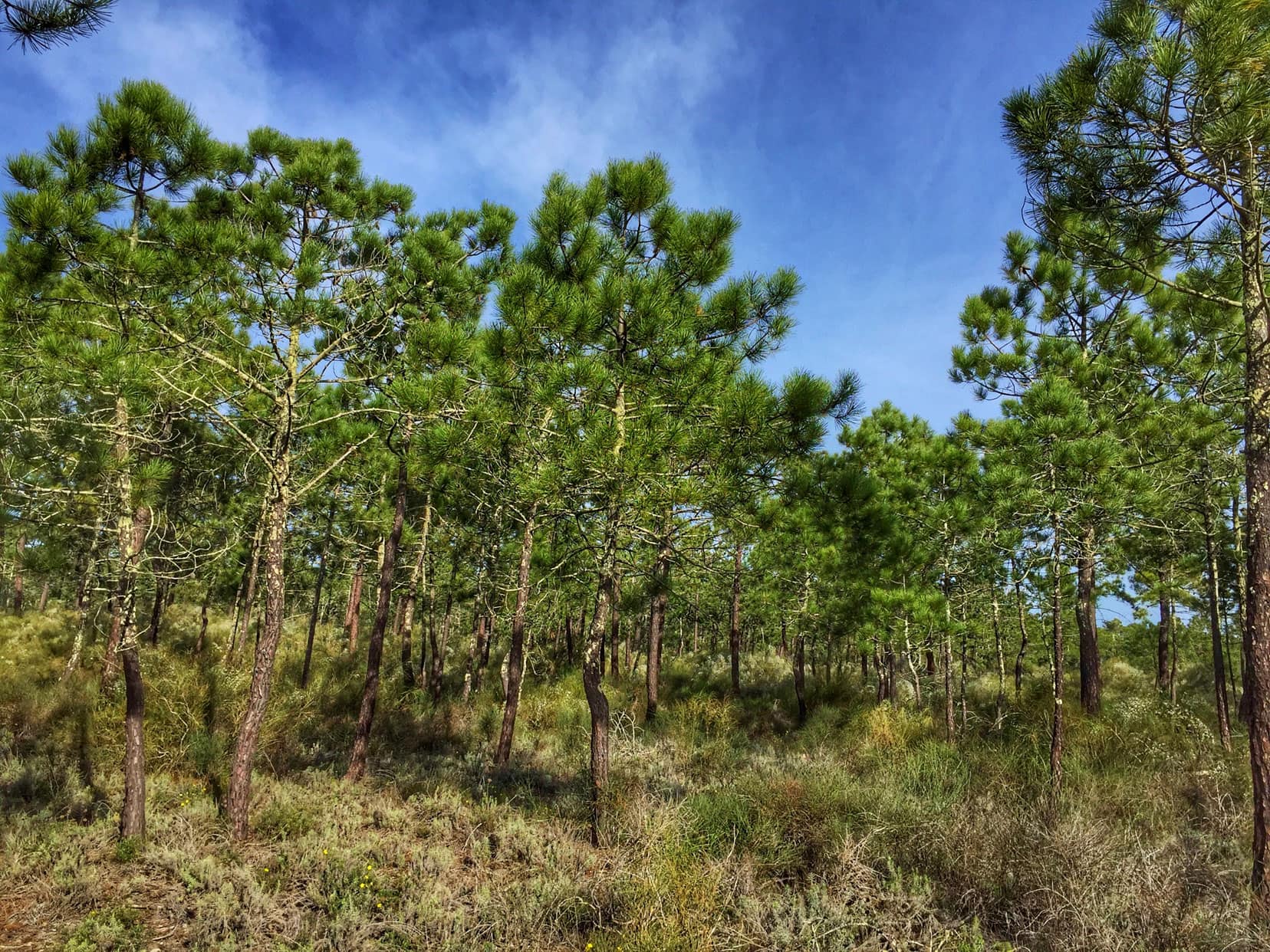
Just be wary of the campsite’s sandy terrain – we learned that the hard way! Our motorhome got bogged, and we ended up having to be pulled out by a tractor.
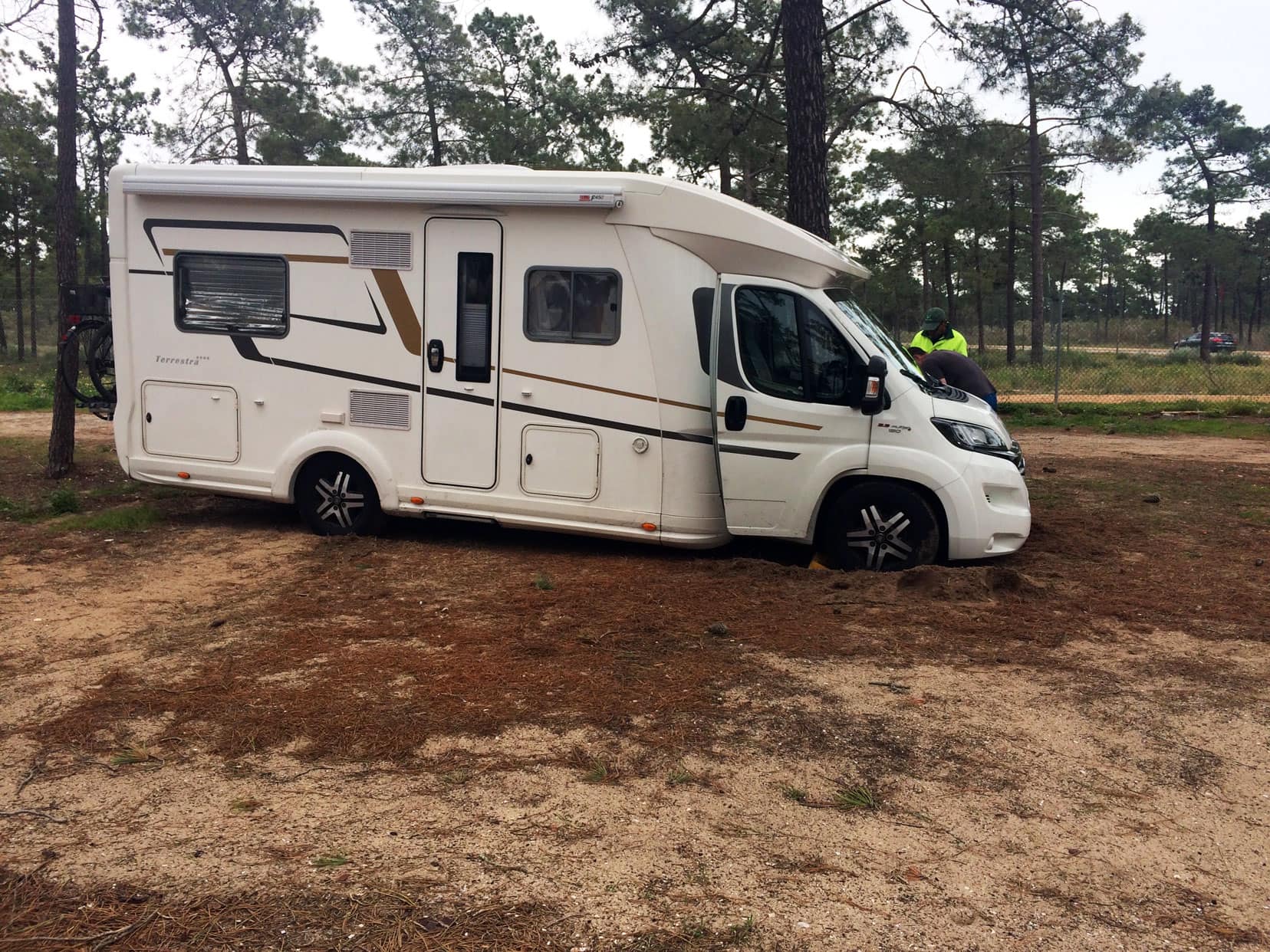
Nearby, the quaint towns of Tavira and Fuseta are worth a visit, offering a peek into the region’s traditional charm.
2. Falesia
🚙 Motorhome / Campervan Stop: Algarve Motorhome Park, Falesia
📏 Driving distance: Monte Gordon to Falesia: 80km
Falesia, nestled between Vilamoura and Albufeira, is fondly known as the ‘Beach Town’. Its standout feature, the Praia da Falesia, stretches for 6 kilometres, fringed by stunning golden cliffs.
The town itself, modest in size, houses several convenient restaurants and shops. Despite its simplicity, the beach’s breathtaking expanse compensates for the town’s lack of quaintness.
Nearby, Vilamoura and Albufeira offer contrasting vibes – the former’s luxury yachts and the latter’s bustling resort atmosphere.
During our tranquil March visit to Falesia, an unexpected health scare reminded us of the importance of being prepared.
🏥 Grab a quote from the travel insurers we use, World Nomads, here
I began experiencing chest pains, leading us to call a 24-hour doctor urgently. Thankfully, they arrived at our campsite within half an hour.
After a day spent in the local hospital and receiving the all-clear, this experience underscored a crucial travel tip: always have travel insurance.
Whether you’re exploring in a motorhome or campervan, ensuring you’re covered is essential. For more insights on why and how to choose the right travel insurance, check out our detailed guide on the importance of travel insurance.
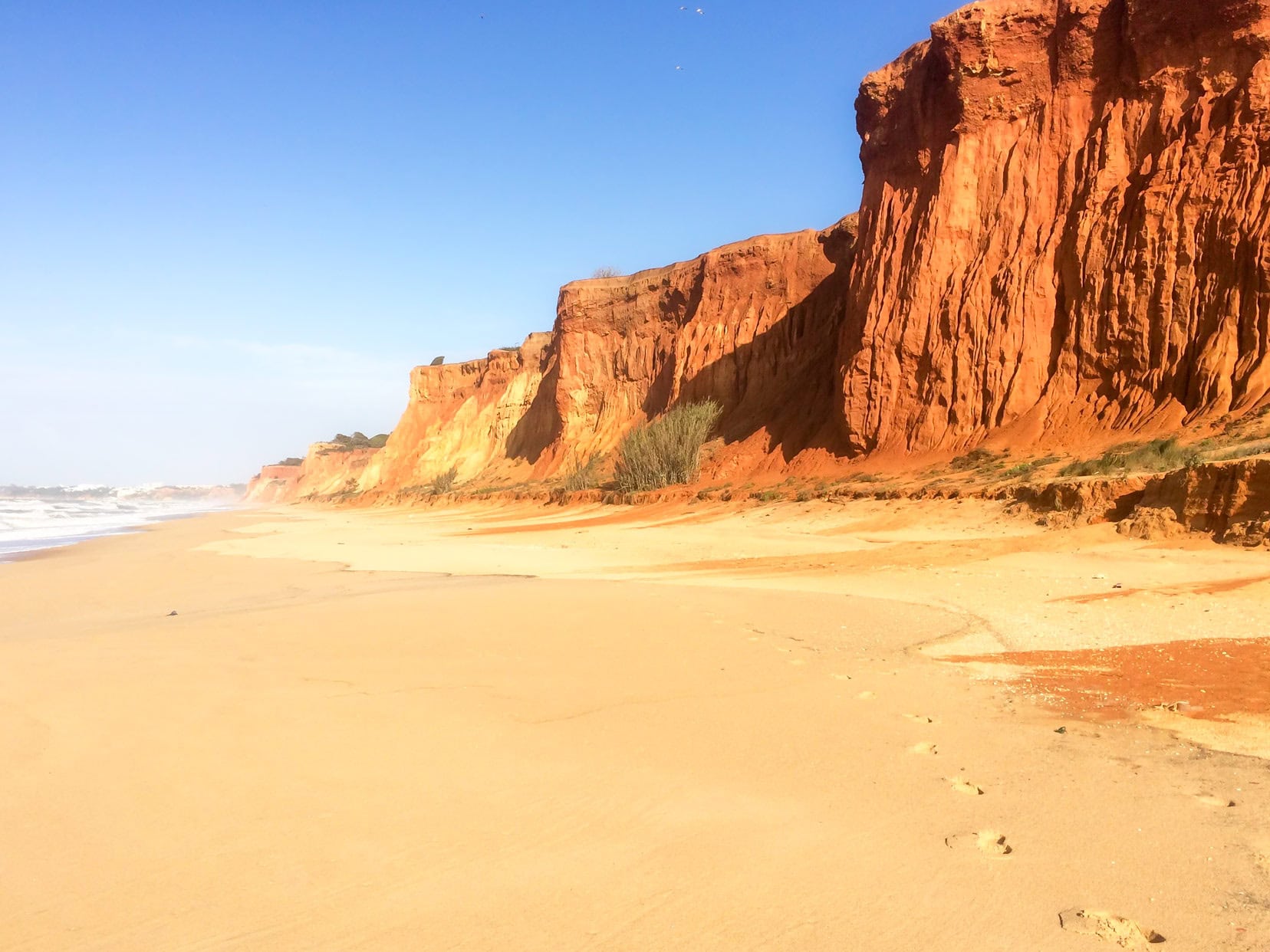
Adhering to our budget travel ethos, we don’t often dine out, but the allure of a local takeaway chicken was too tempting to resist.
An amusing wait ensued. I think they cooked it from scratch, culminating in the surprise of receiving what might be the world’s smallest cooked chicken!
So, if you happen to fancy the world’s tiniest cooked chook, smaller than your average pigeon, you might just be in luck. We can’t remember which cafe it was, so you’ll have to ask around;)
Adding to the intrigue, we encountered a Portuguese Man O’ War on the beach. Although not indigenous to Portugal, as we initially thought, its resemblance to 15th-century Portuguese battleships gave it its name.
Although rarely deadly, these pretty puff bags with beautiful blue tentacles pack an excruciating, painful punch. Widely touted as a jellyfish, it is actually a siphonophore, meaning it is a colony of organisms rather than one.
Regardless of what you call it, you really want to keep a good socially accepted distance from this one.
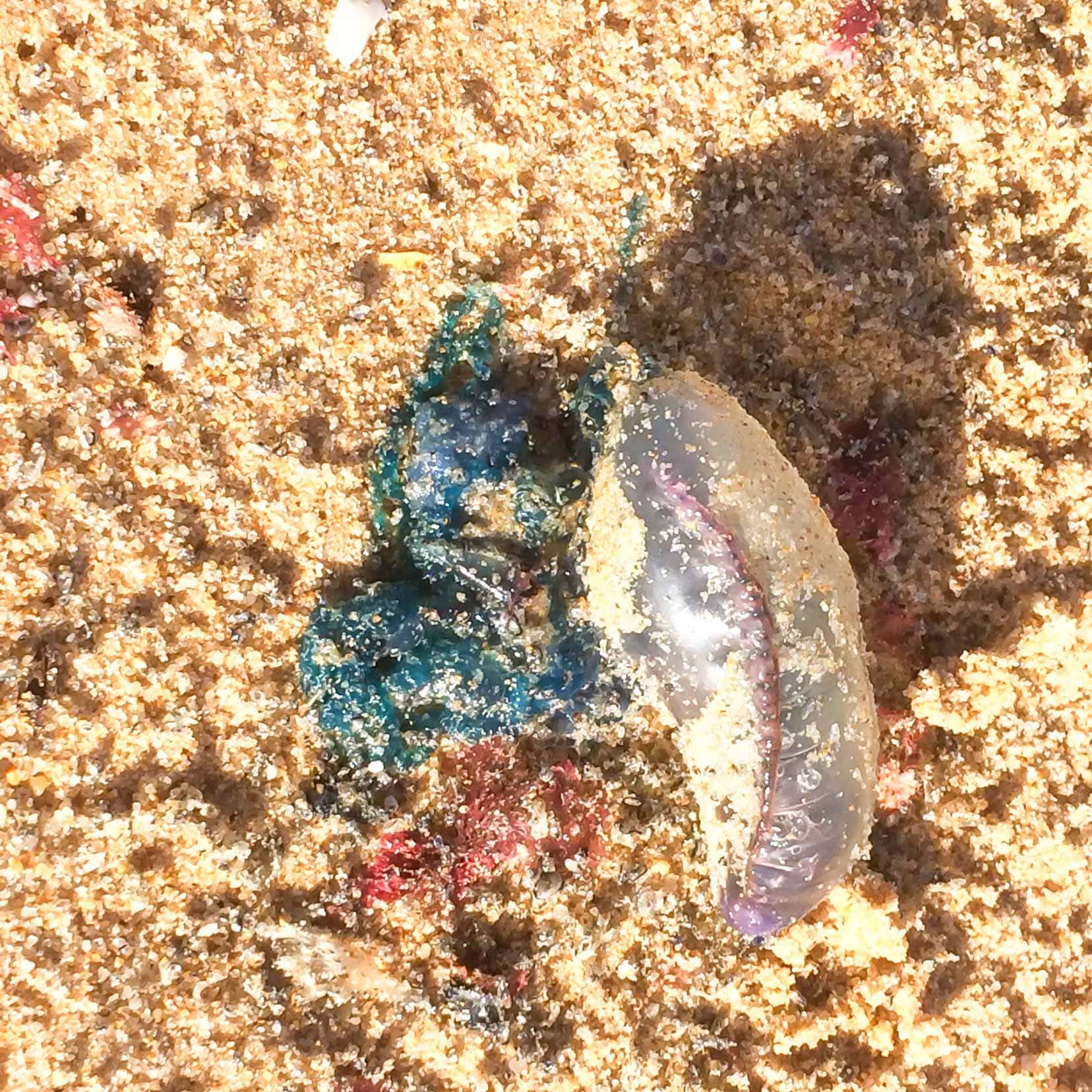
3. Sesimbra
🚙 Motorhome / Campervan Stop: Sesimbra Car Park or Camping Forte do Cavalo
📏 Driving distance: Falesia to Sesimbra: 262km
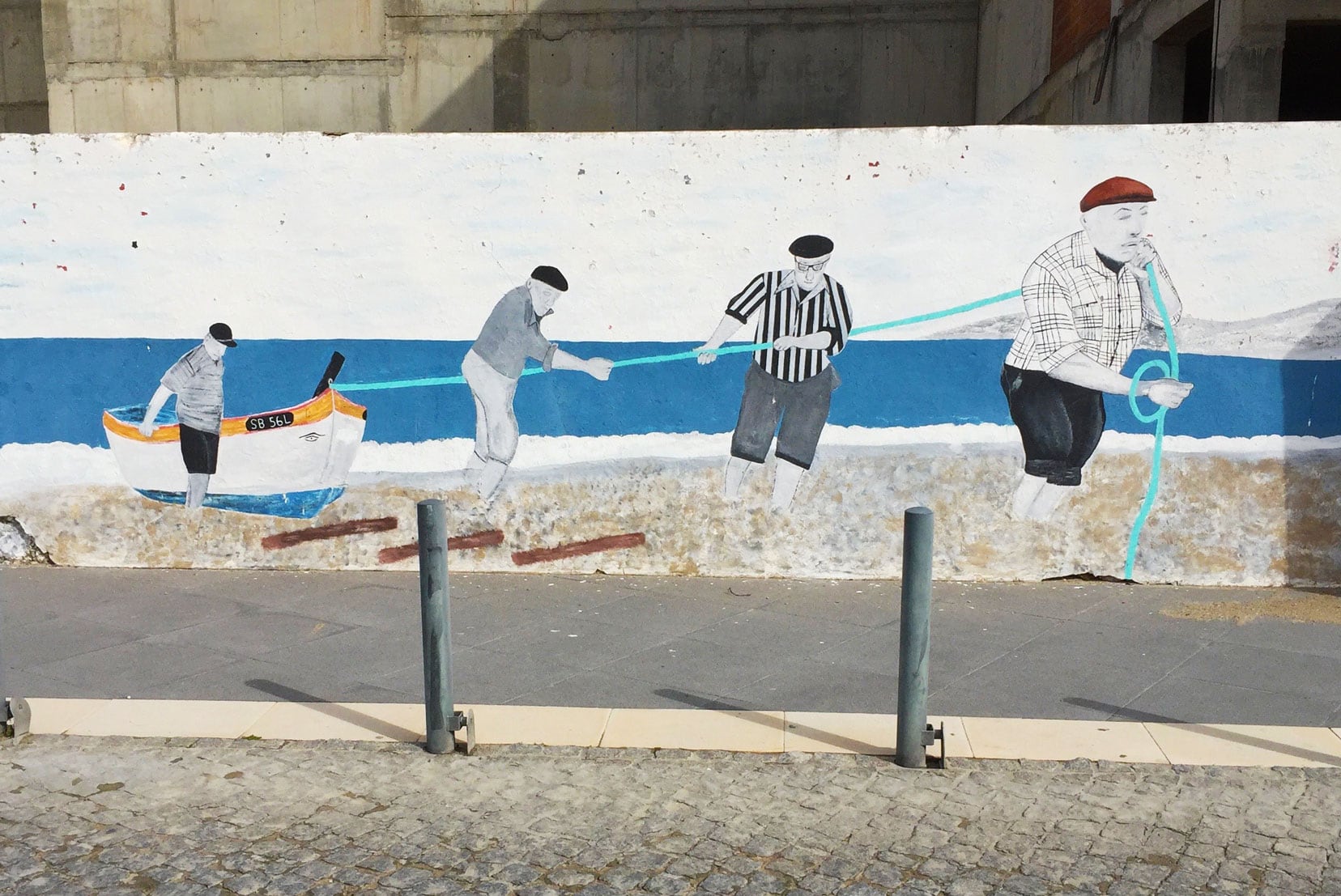
There is no doubt, when wandering the streets of Sesimbra, that this town has grown up around the fishing industry.
Street art abounds on Sesimbra’s walls, and even many of the town’s doors and windows reflect the fishy nature of the town.
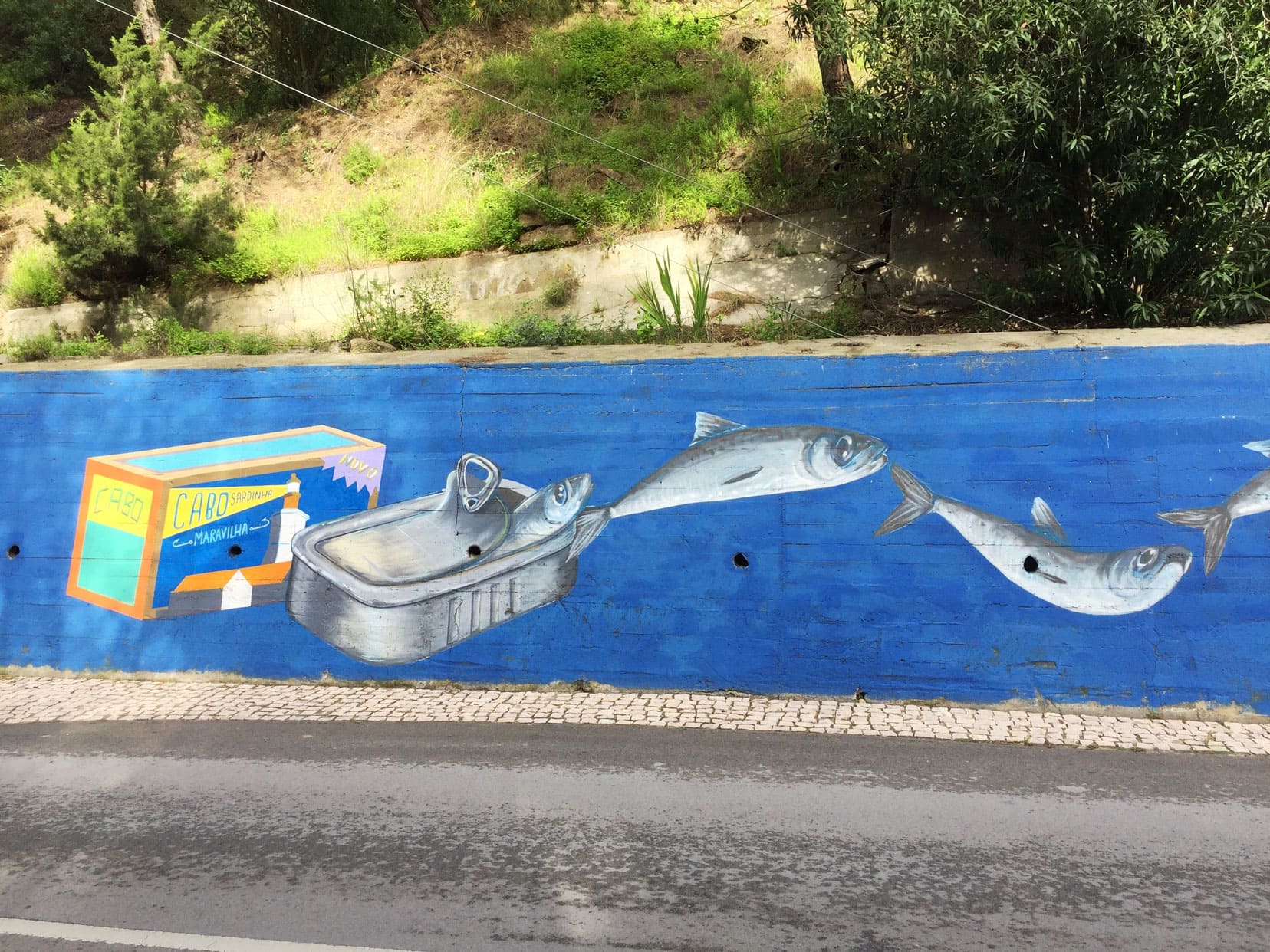
The curved bay of Sesimbra is protected by the surrounding hills of the Parque Natural da Arrábida, a mountainous area covered in thick shrubs and pine forest with a few hidden sandy coves known mainly by locals.
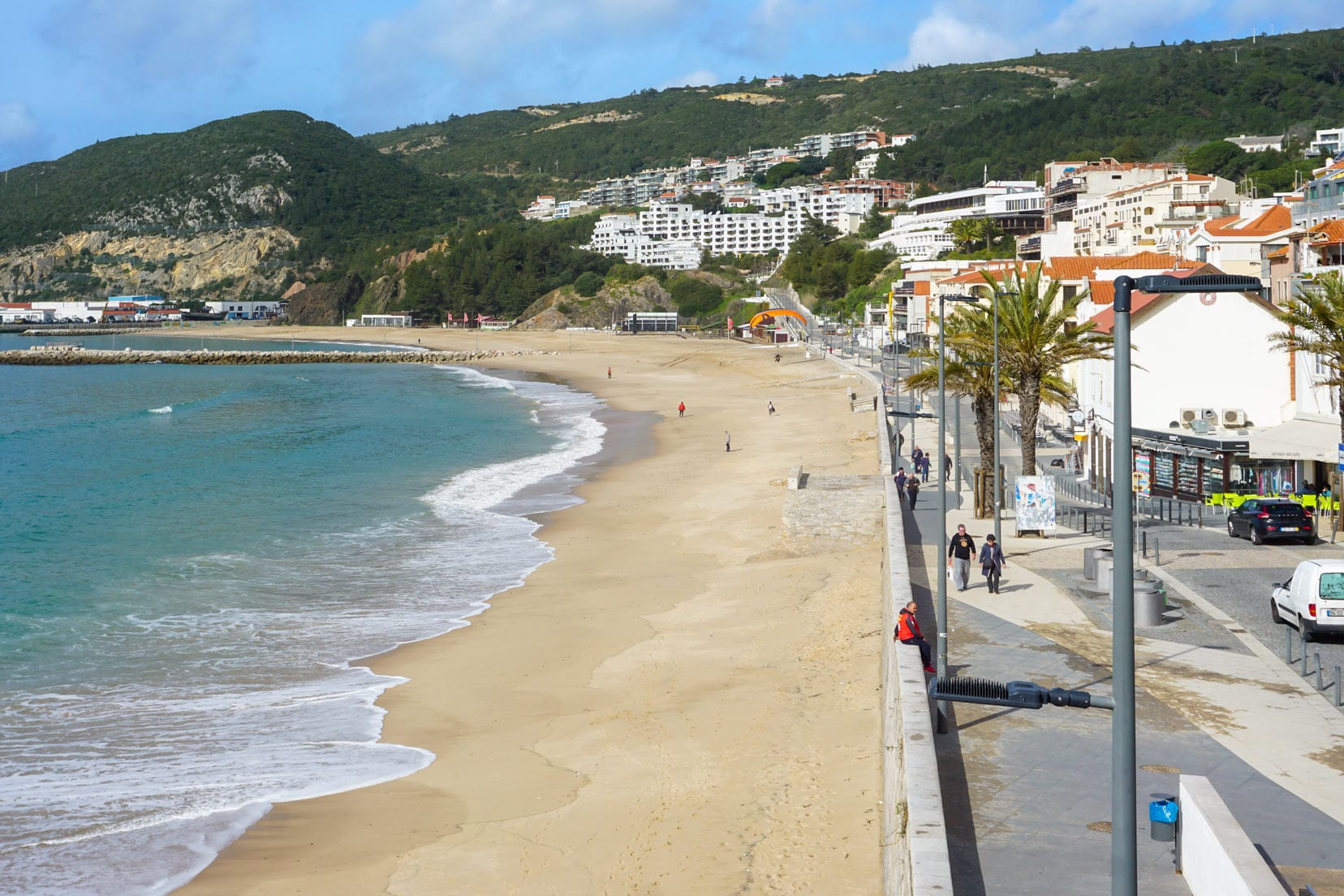
Take a walk to the fishing jetty at the end of the beach and watch the hustle and bustle of fishermen and their brightly coloured fishing boats.
The seagulls do a good clean-up job, making neat work of the discarded heads and tails.
From the jetty, if you look towards the bay, high on the distant hills on the left, you’ll spot Sesimbra Castle, a national monument since 1910.
The entrance to the castle is free, but it is a steep 230m climb to the top.
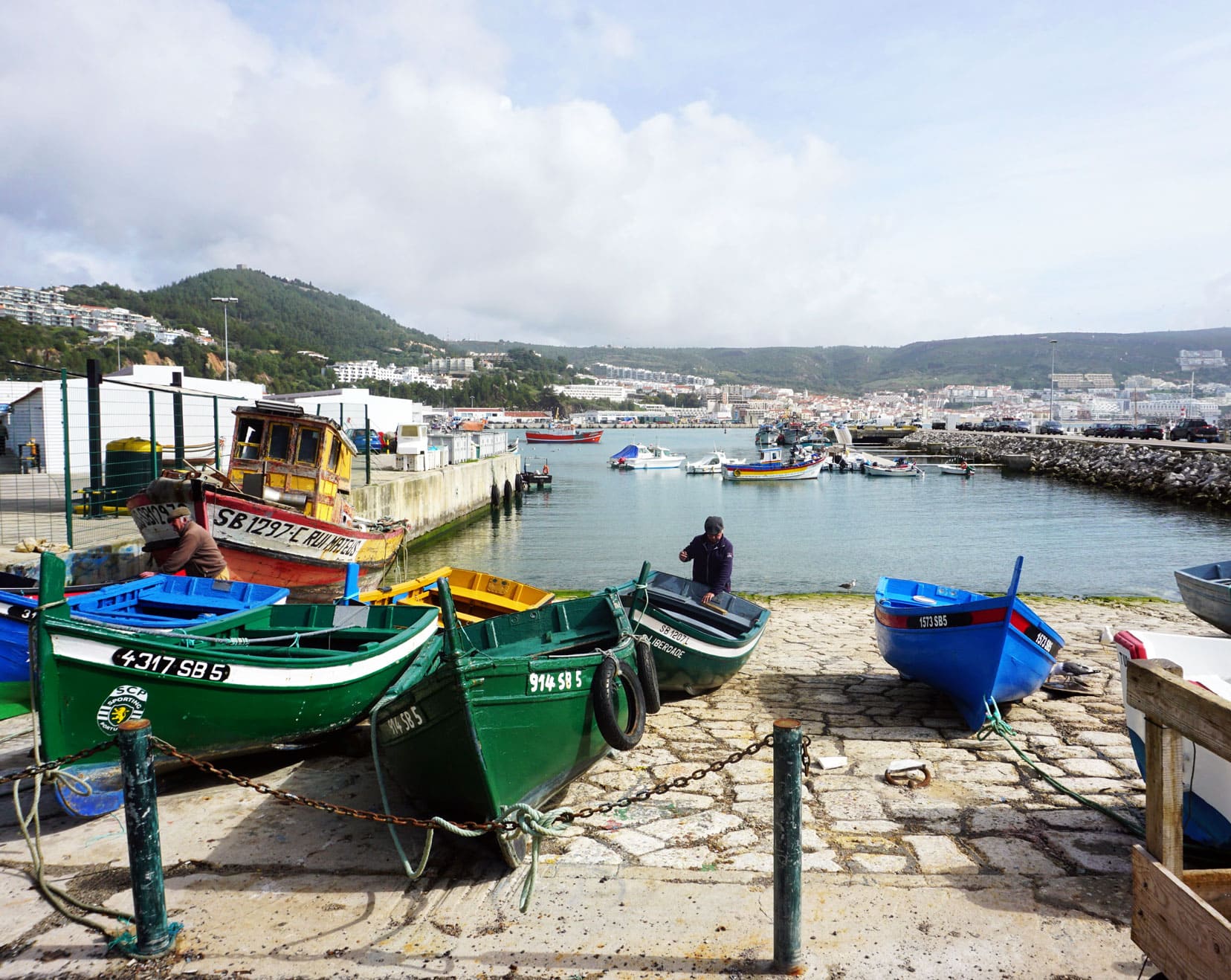
With fish coming fresh from the sea – what better place to have an all-you-can-eat sushi lunch – surprisingly made by a lovely Chinese couple who had immigrated to Portugal.
Sesimbra also has a special traditional sweet, the ‘Farinha Torrada‘. This sweet is made of flour, chocolate, lemon, and cinnamon and is intended for fishermen to take out to sea as an energy bar.
4. Cabo Espichel
🚙 Motorhome / Campervan Stop: Cabo Espichel
📏 Driving distance: Sesimbra to Cabo Espichel: 20km
About ten kilometres west of Sesimbra, you’ll find the peninsula of Cabo Espichel. A stunning wild landscape of plummeting cliffs, roaring waves, a moody lighthouse, a pilgrim’s sanctuary and even the giant footprints of Sauropod dinosaurs.
It also has free motorhome parking for the night, so it’s an ideal place to stop on your Portugal motorhome tour.
The Sanctuary of Our Lady of Cape Espichel, also known as Nossa Senhora do Cabo Espichel, was where pilgrims gathered in such numbers that extra accommodation wings had to be built to accommodate them all.
They were coming to visit the place where the Virgin Mary had been seen in a vision riding a giant white mule along the cliffs of Cabo Espichel.
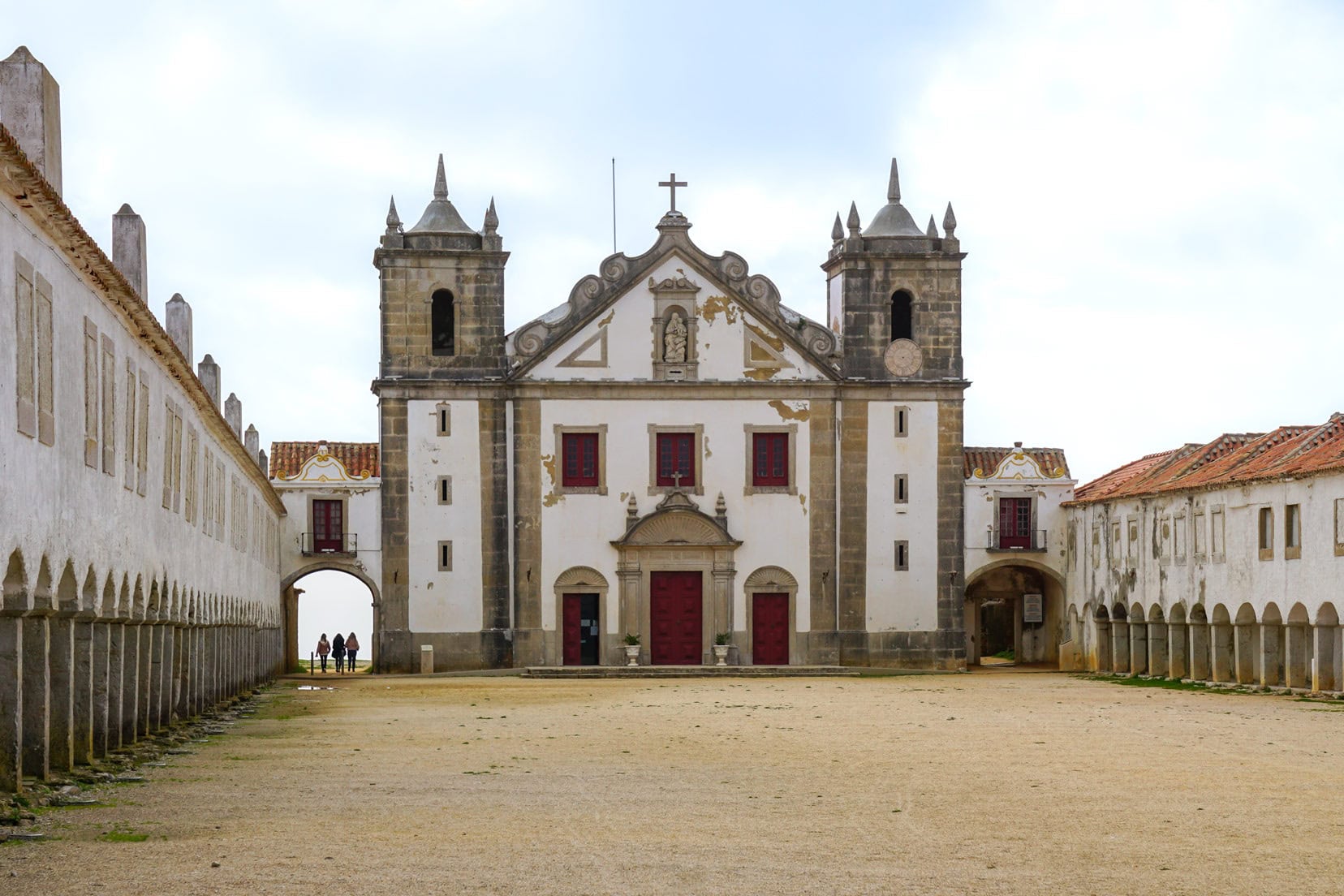
The Memory Chapel (Ermidade Memoria) is a tiny chapel perched on the edge of the Cabo Espichel cliffs.
Legend has it that two visionaries saw the Virgin Mary riding a white mule up the steep cliffs, and the chapel is a memorial to this. Azulejo tiles depict the miraculous story on the walls inside.
On the cliff face below the Memory Chapel are a set of large footprints. Back in the day, locals and pilgrims assumed these were ‘giant mule’ prints from the Virgin Mary’s visitation, but alas, they are actually dinosaur footprints.
You can see them, with binoculars, from the cliff across the way.

It wasn’t raining, so the windy weather was perfect for blowing the cobwebs away and taking a brisk walk along the coast. Clear blue skies greeted us at first, but as the afternoon moved on, the clouds and sea mist moved in, creating an eerie atmosphere on this historical clifftop.
We snapped the Cabo Espichel lighthouse photo (below) a few moments before the encroaching fog swallowed it.
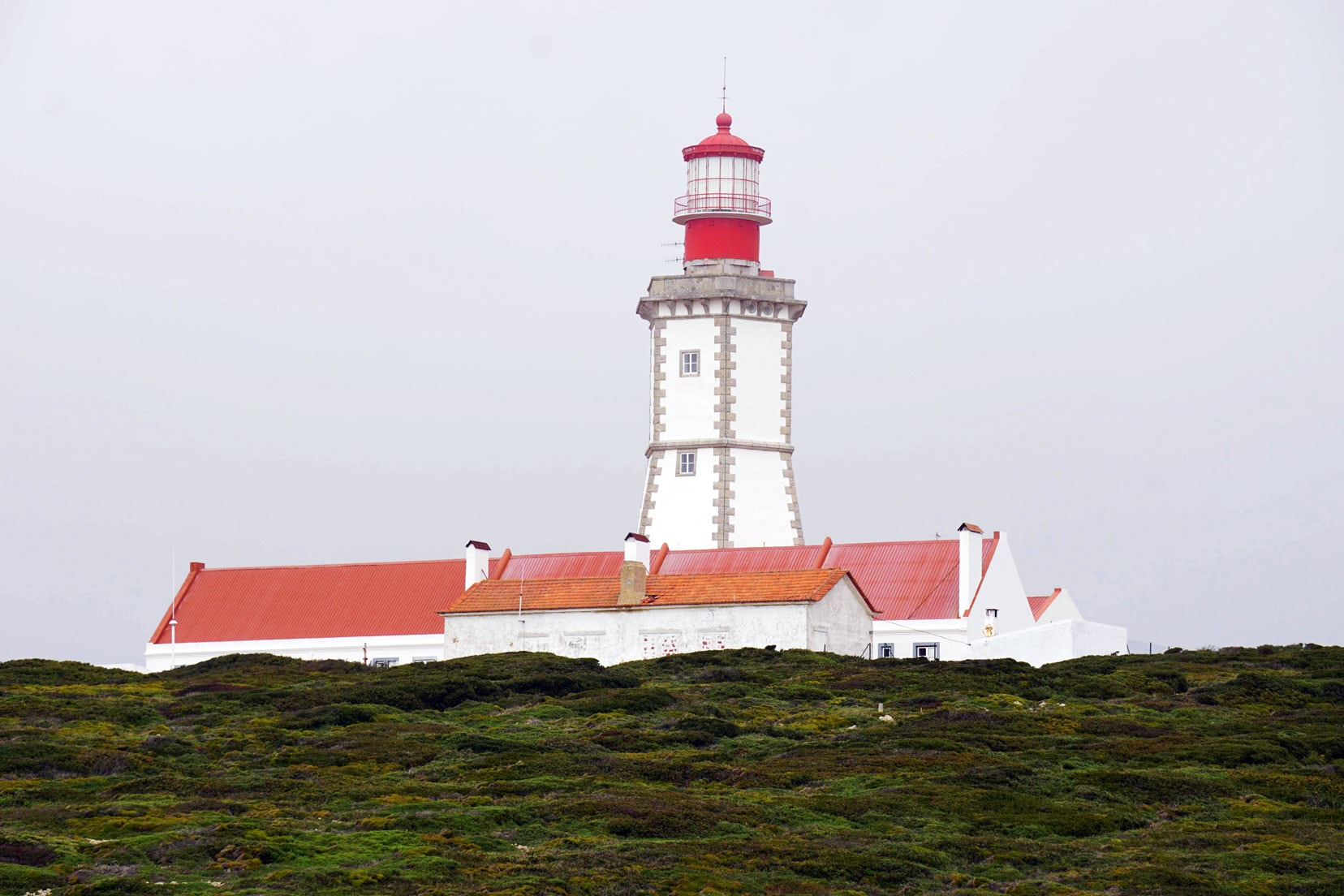
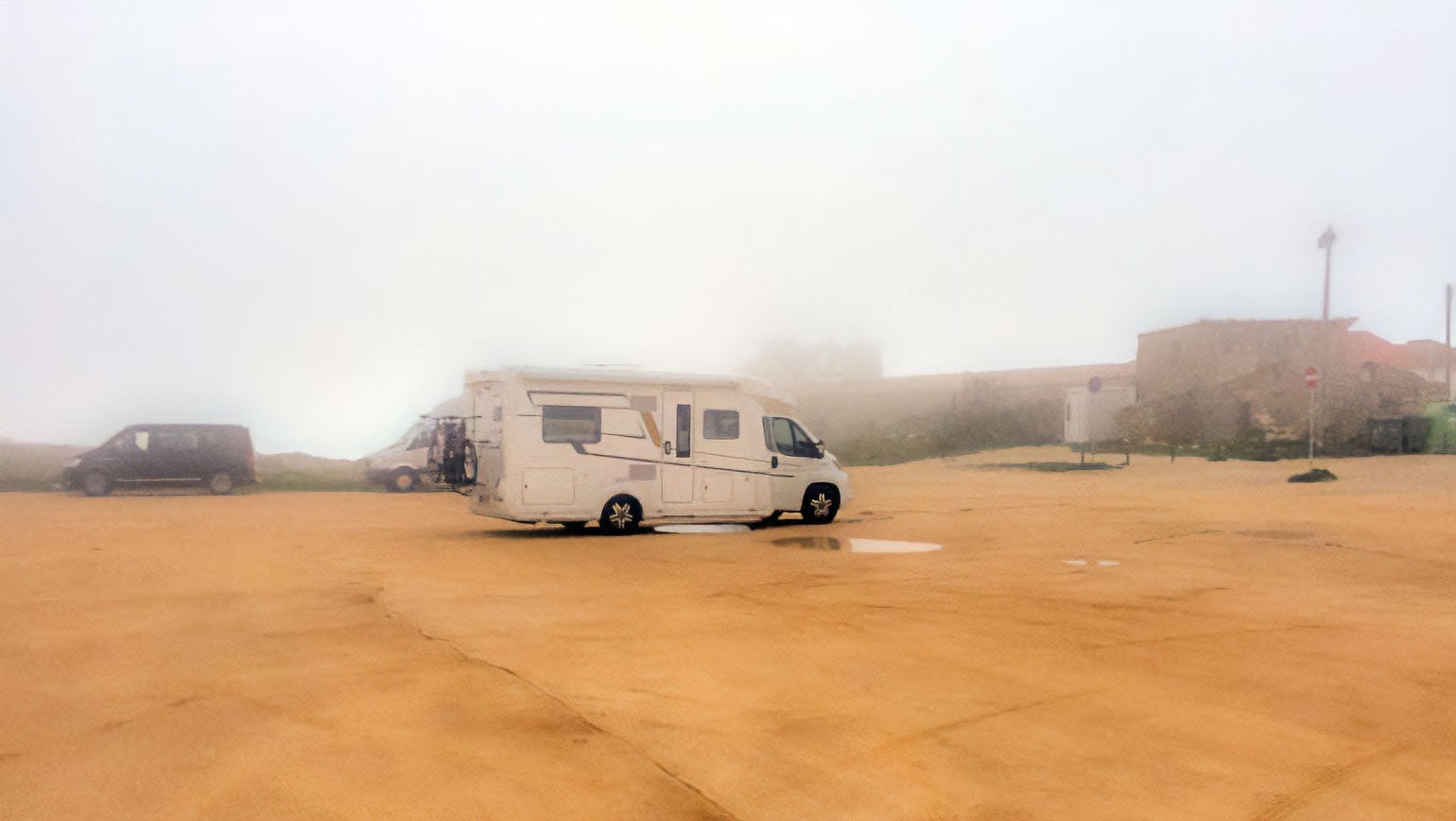
5. Sao Joao de Areias (Between Coimbra and Serra Da Estrela)
🚙 Motorhome / Campervan Stop: Terra d’Iguana Camperplek
📏 Driving distance: Cabo Espichel to Sao Joao De Areias: 300km
Terra d’Iguana campervan stop in Sao Joao de Areias is a wonderfully welcoming place to overnight – or even stay for a few days on your Portugal campervanning trip.
The owners, Gerrit and Elly, make sure that everything is just right for you. The price of 12.50 Euros is all inclusive of electricity, WIFI, use of the swimming pool and BBQ. And they even delivered fresh bread to us each morning.
Gerrit is a bit of a character. He loves photography, Star Wars, baking, and iguanas (he has one in the house) and never drinks water—only Coke, consuming, on average, 10 cans a day! If you stay there to say hi to them from us, they are a lovely couple.
There is a forest walk near the campsite, and the area is great for geocaching.
The tiny village of Sao Joao de Areias is positioned between Coimbra (the city famed for its UNESCO World Heritage University) and the Serra da Estrela National Park in Central Portugal.
It is also just over an hour and a half from the UNESCO Arouca Geopark.
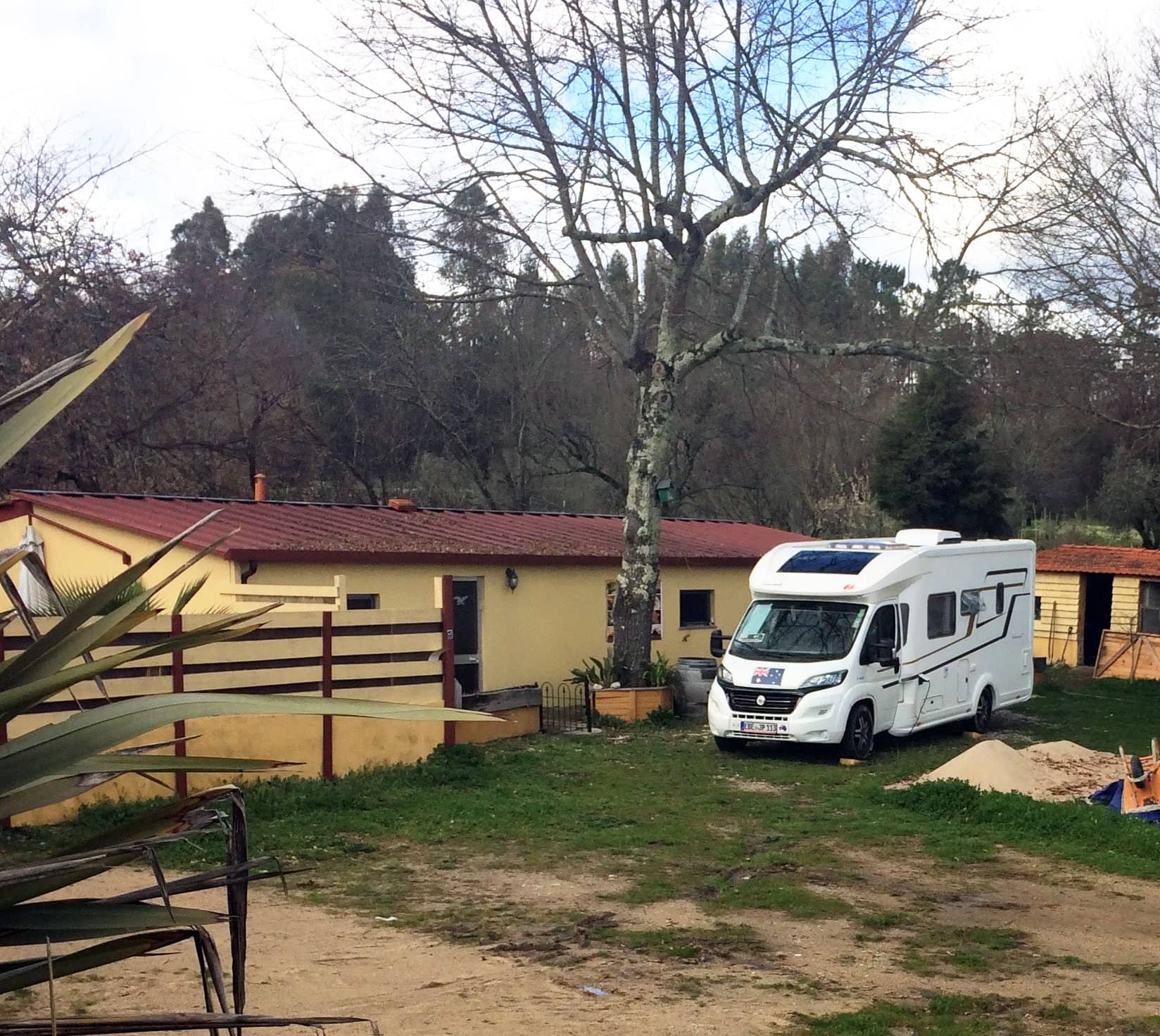
Coimbra
Not only does Coimbra house the oldest university in Portugal, and indeed one of the oldest in Europe, dating back to the 13th century, but here you can also visit historic monasteries, the Sé Velha cathedral, the botanical gardens and a mini version of Portugal’s most famous monuments and places at Portugal dos Pequenitos.
Serra da Estrela Natural Park
Serra da Estrela Natural Park, over 100 thousand hectares, is the largest protected area in Portugal. Within it is Portugal’s highest peak, Torres, at 1993m.
With rivers, glacial valleys and sheep shepherded by the hardy Serra Estrella dogs, this is an expansive place to roam and escape into nature.
There are also 12 historical villages dotted around central Portugal, with many boasting medieval castles.
So you won’t be short of places to explore in the area.
Arouca UNESCO Geopark
Another UNESCO attraction in the area is the Arouca Geopark, 378 square kilometres of preserved geological history.
Here, you’ll find the Paiva Walkways, an 8km walk just crying out to nature lovers.
The walk takes you along the bank of the Paiva River, with many wooden walkways and steps snaking along the curves and bends of this protected landscape. It is considered high difficulty and takes about two and a half hours.
Along with the Paiva Walkways you’ll also find the world’s longest pedestrian suspension bridge, the 516 Arouca. It stretches for 516 metres over the Paiva Gorge 175 metres below.
You can book a tour that covers your Arouca suspension Bridge ticket and also explore the Paiva Walkways with a knowledgeable guide.
From Arouca: 516 Arouca Bridge & Paiva Walkway Tour | ⏳ 4 hours | ⭐️ 4.9/5 star reviews | Book here
The tour is also available from Porto, where you will discover the beautiful Paiva Walkways, cross the Arouca 516, relax on a boat trip through the canals in Aveiro and wander through the city centre.
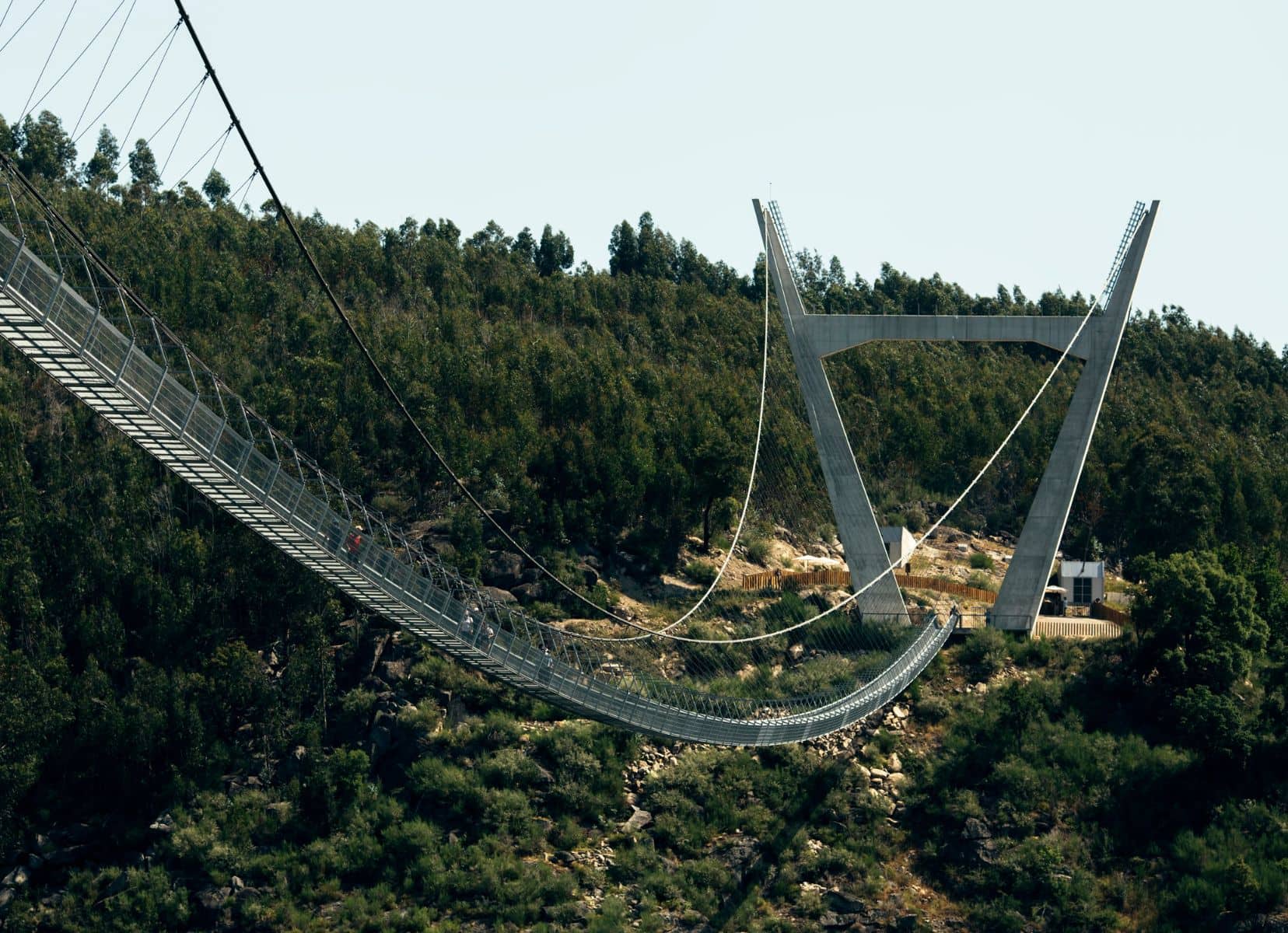
6. Porto
🚙 Motorhome / Campervan Stop: Parque Biologico de Gaia
📏 Driving distance: Sao Joao De Areias to Porto: 156km
Porto is the second-largest city in Portugal (with Lisbon, Portugal’s capital, being the first) and is at the mouth of the river that meanders through the Douro Valley.
It’s a popular tourist destination, so we were lucky to be exploring Porto in the off-season. Though, even then, the city was busy.
Porto’s many churches, walls, buildings and even the inside of the main train station showcase azulejo tiles (painted ceramic tiles) facades and interiors.
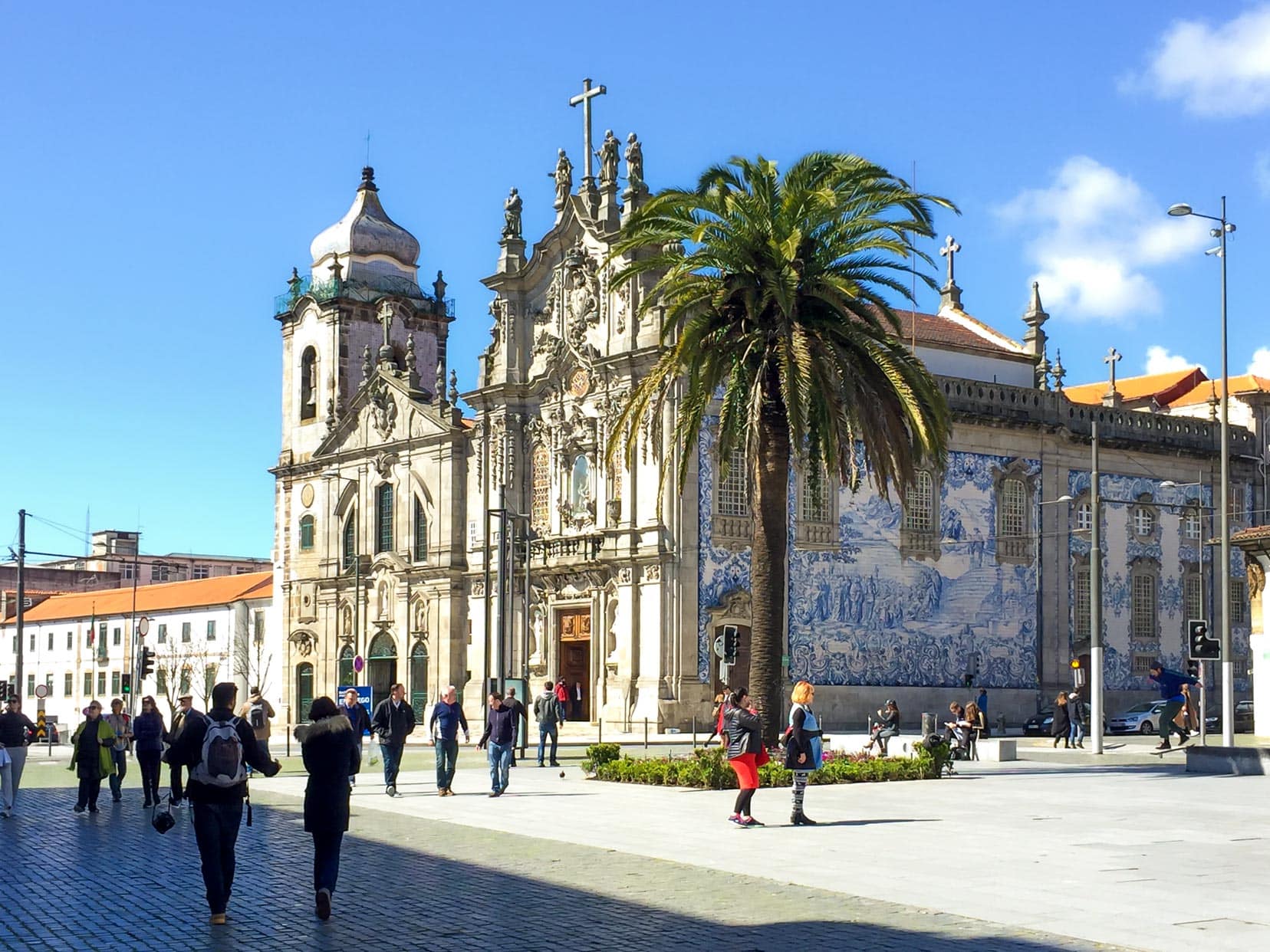
Livararia Lello
In the heart of Porto, you’ll find one of the most beautiful bookshops in the world, Livraria Lello.
I love bookshops. I’m not sure what it is about them, but I can spend hours browsing the shelves. If we had time, I would have spent days here!
Unlike most bookshops, you do have to pay to visit this one. It’s 8 euros, but if you buy a book, it’s deducted from the price.

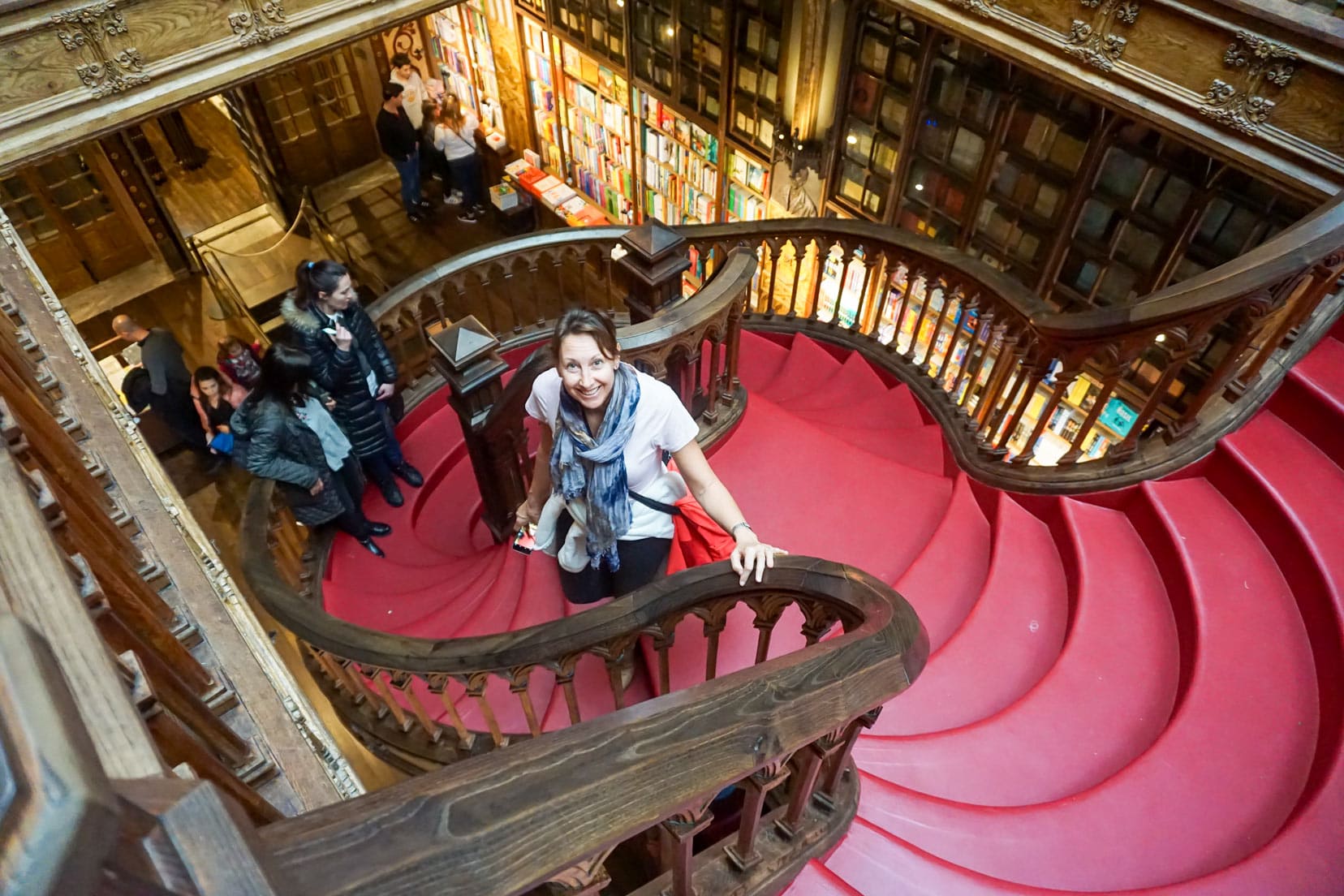
Porto’s old town, the Ribeira district, is lined with strips of terraced houses, bars and restaurants amongst old cobbled streets.
Trams trundle by, and you can imagine a simpler time in days gone by.
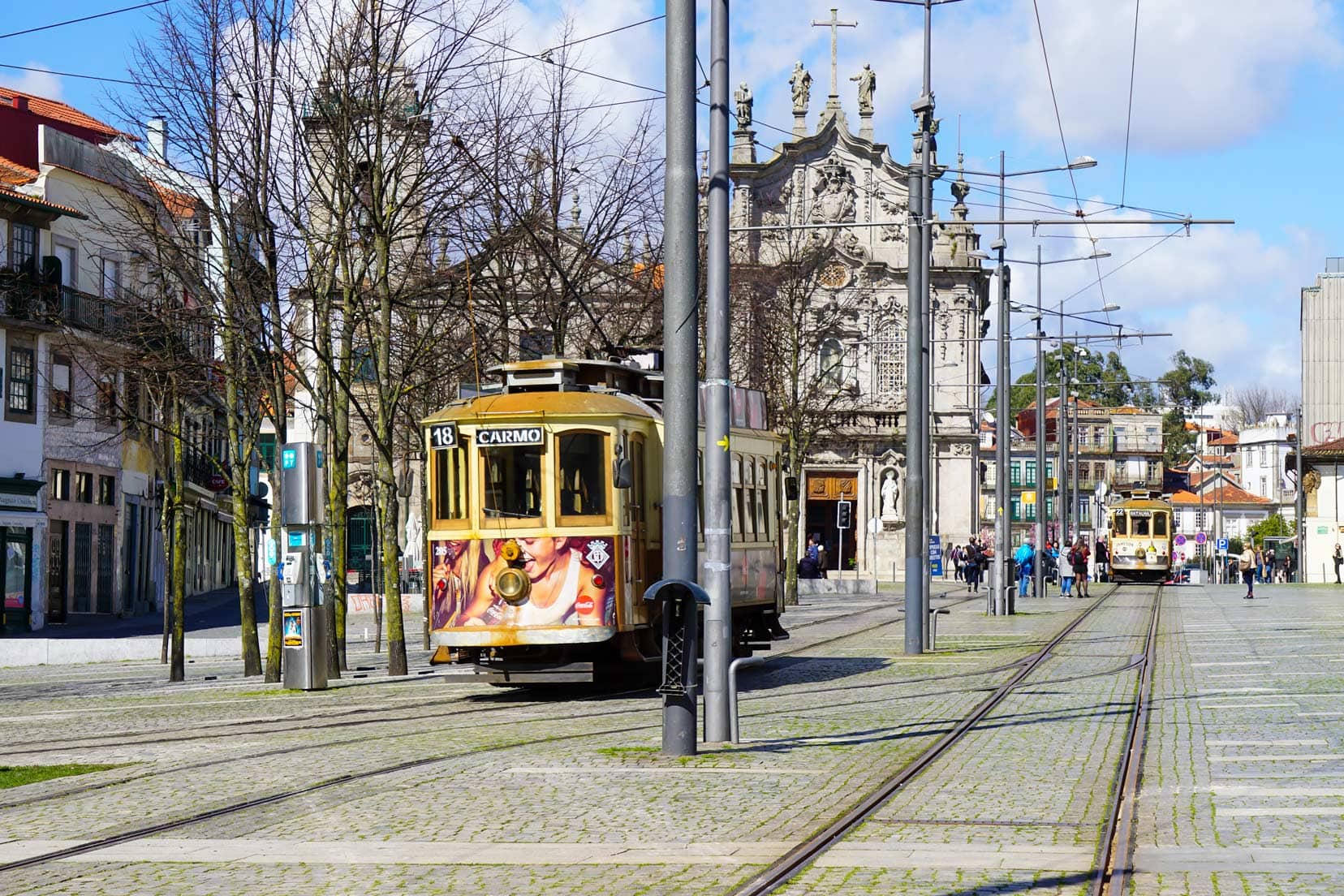
On the opposite bank, across the most famous of Porto’s six bridges, the Dom Luis I, Vila Nova de Gaia shoreline is filled with a succession of Port cellars filled with casks and bottles of the sweet liquid produced in the Douro Valley since Roman times.
Consider a Porto Food and Wine Tasting Tour with a local guide. From old taverns to traditional cafes, try the local delicacies and learn why northern Portugal’s best traditional cuisine is in Porto.
🍷Find out more or Book this popular 5-star-reviewed Porto Wine Tasting Tour today | ⏰ 3 hours| ⭐️ 5/5 Star reviews
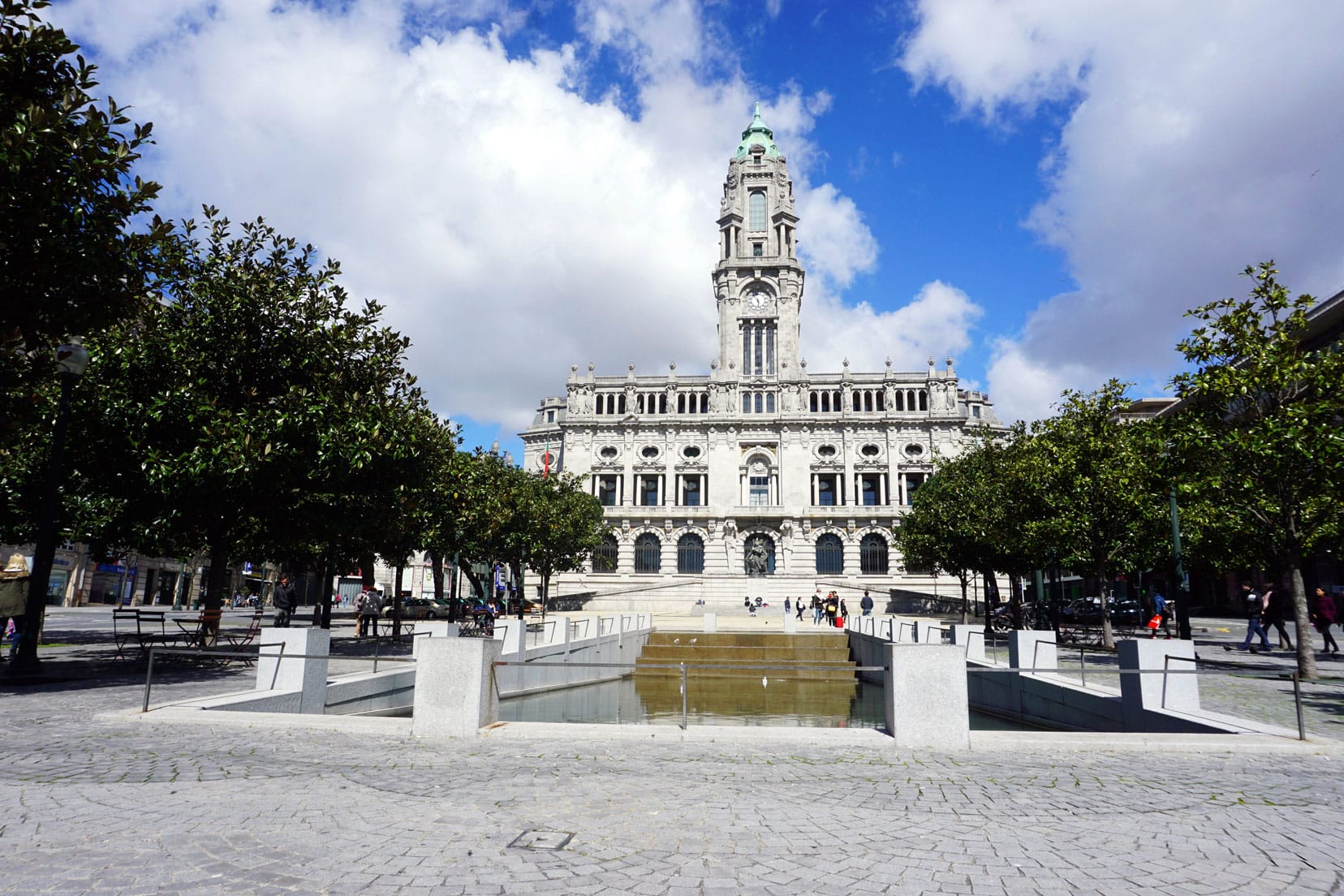
We camped and parked the motorhome at Parque Biologico de Gaia, a fabulous wildlife reserve. From there, it was easy to catch a bus to Porto.
An added bonus of parking the camper here was that we had free entry to the reserve, and it is a lovely place to stroll through and connect with nature.
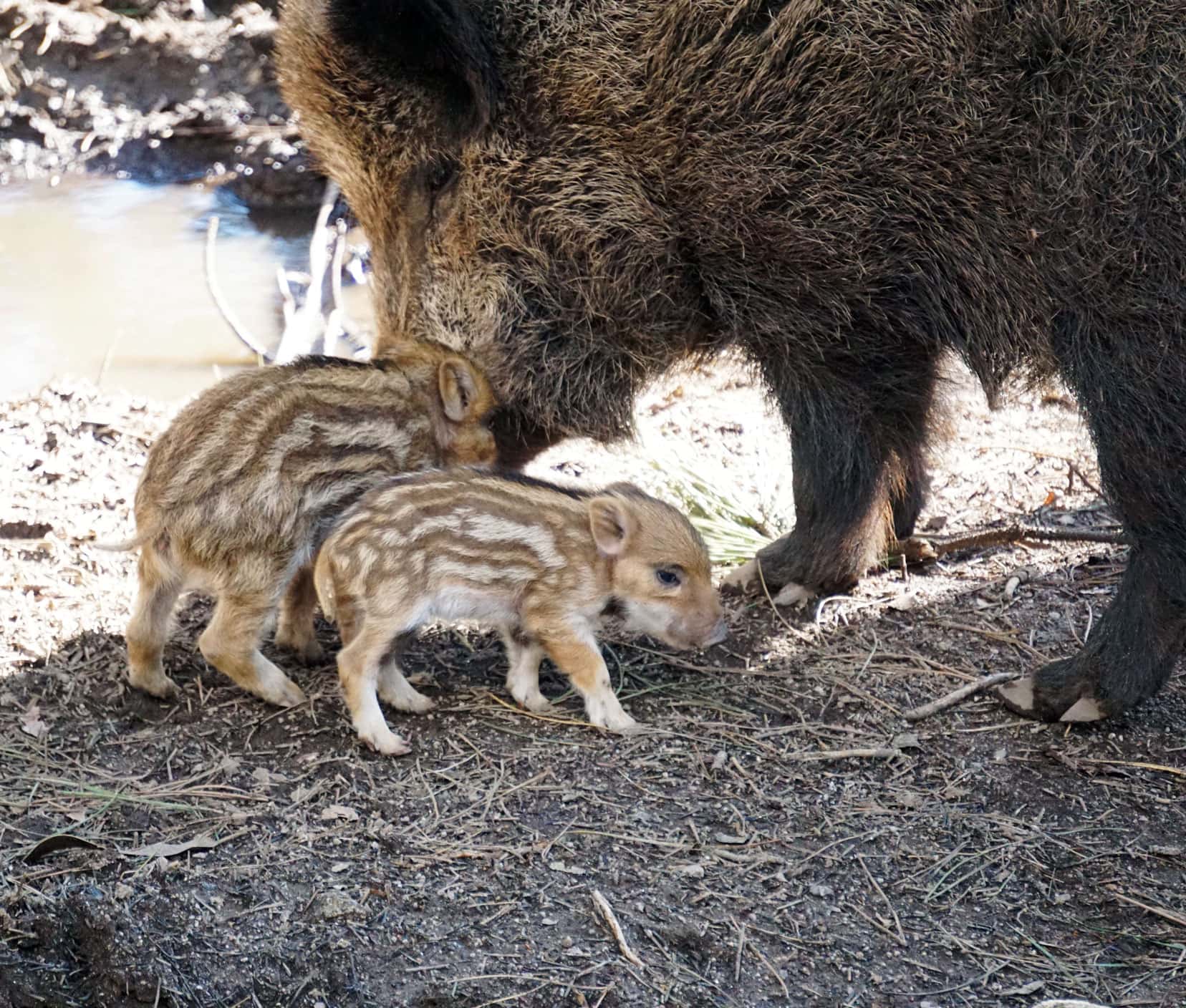
7. Douro Valley
🚙 Motorhome overnight stop next, at Regua.
📏 Driving distance: Porto along the Duoro River to Regua: 150km
Designated by UNESCO, the Alto Duoro wine region has been producing wines here for 2000 years. So, it’s no surprise that Douro Valley has about 200 Quintas (wine estates) along its banks.
A trip along the windy roads of this region is a journey filled with verdant terraced hills perched above the glistening Douro River below.
We took the N222 from Porto and meandered along the valley to our next stop at Regua.
We later found out that the next section of the N222, after Regua, and on to the small town of Pinhão, is one of the most scenic drives in Portugal. So, if you are motorhoming in Portugal – we suggest going the extra few kilometres to explore this section of the Duoro Valley.
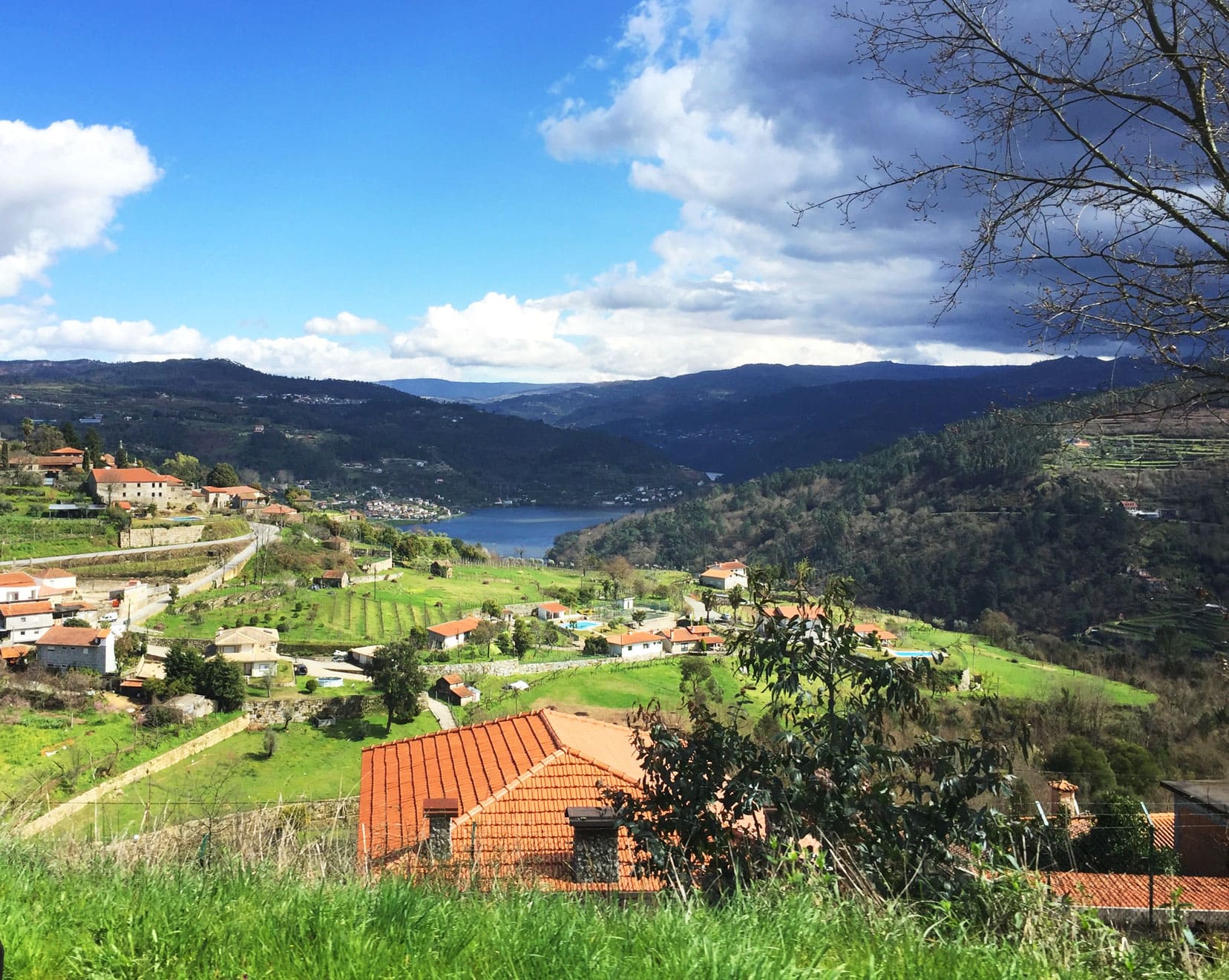

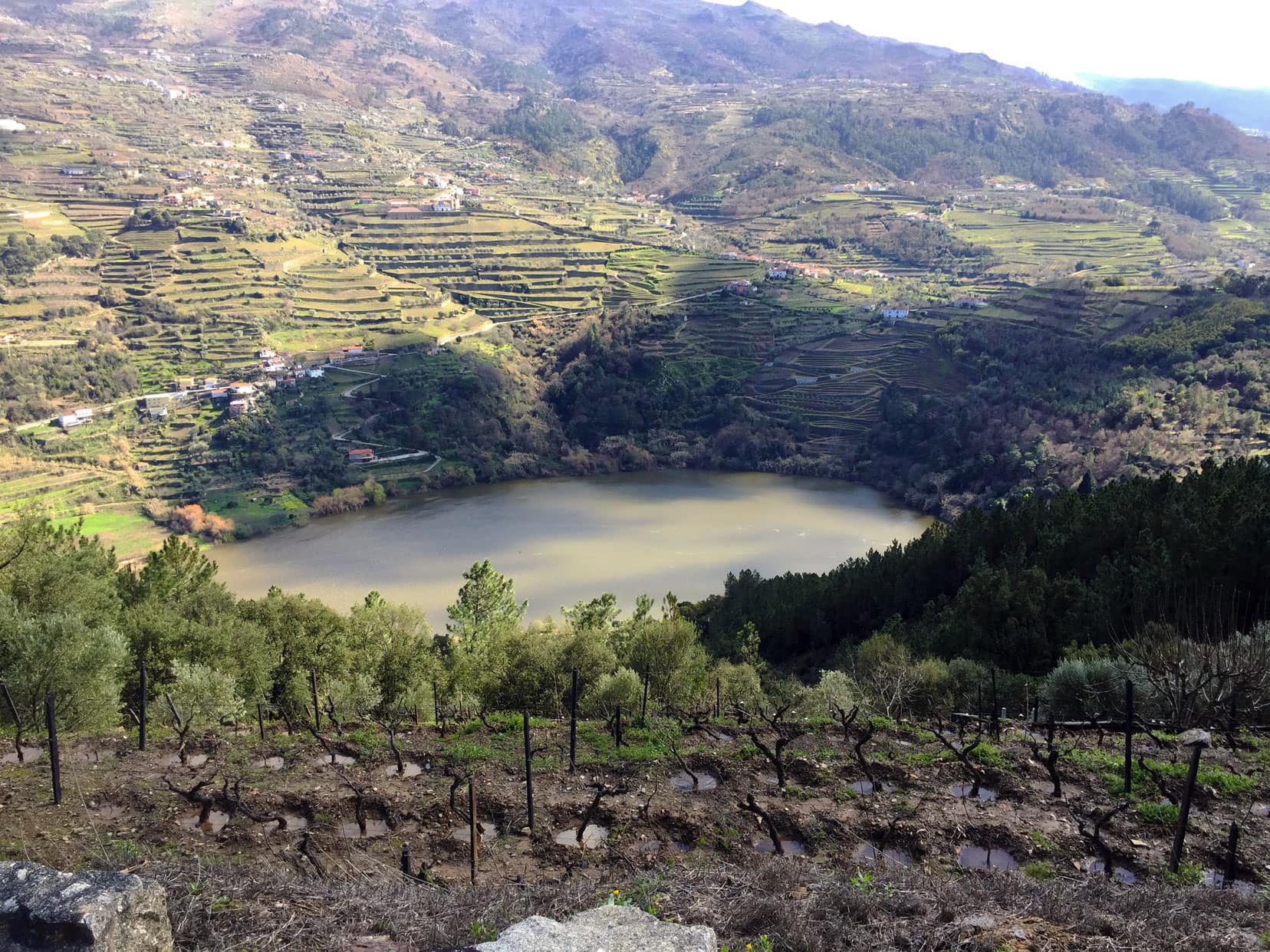
8. Peso Da Regua
🚙 Motorhome / Campervan Stop: Parque de Pernoita de Autocaravanas
📏 Driving distance: Porto along the Duoro River to Regua: 150km
We continued our campervanning in Portugal trip through the Douro Valley and parked our motorhome for the night on the banks of the River Douro underneath Peso da Régua’s three bridges.
The city was recognized as the International City of Vineyards and Wine in 1988 and although not that pretty, it’s a great motorhome stop.
In the past, special boats, called barcos rabelos, transported wine barrels down the Douro River from Peso da Reguato to Vila Nova de Gaia.
The main attraction in Regua is the Douro Museum, where you can learn more about the history of the Douro Valley. The museum also houses a shop where you can buy plenty of artisanal products.

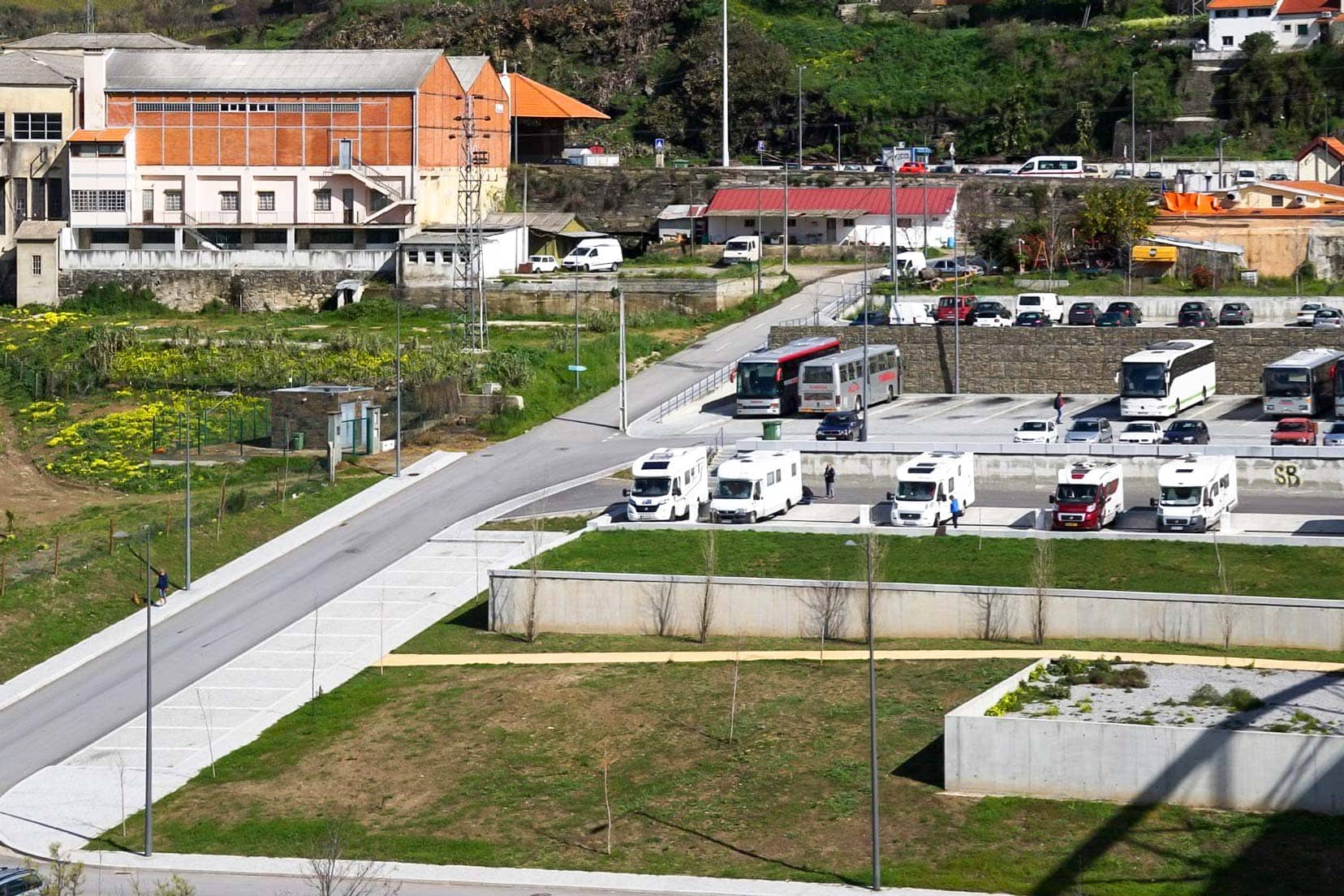
After leaving Regua, we headed northeast towards Spain. On the way, we passed the Corgo Viaduct, which is quite some feature at 220m high and 2.8km long.
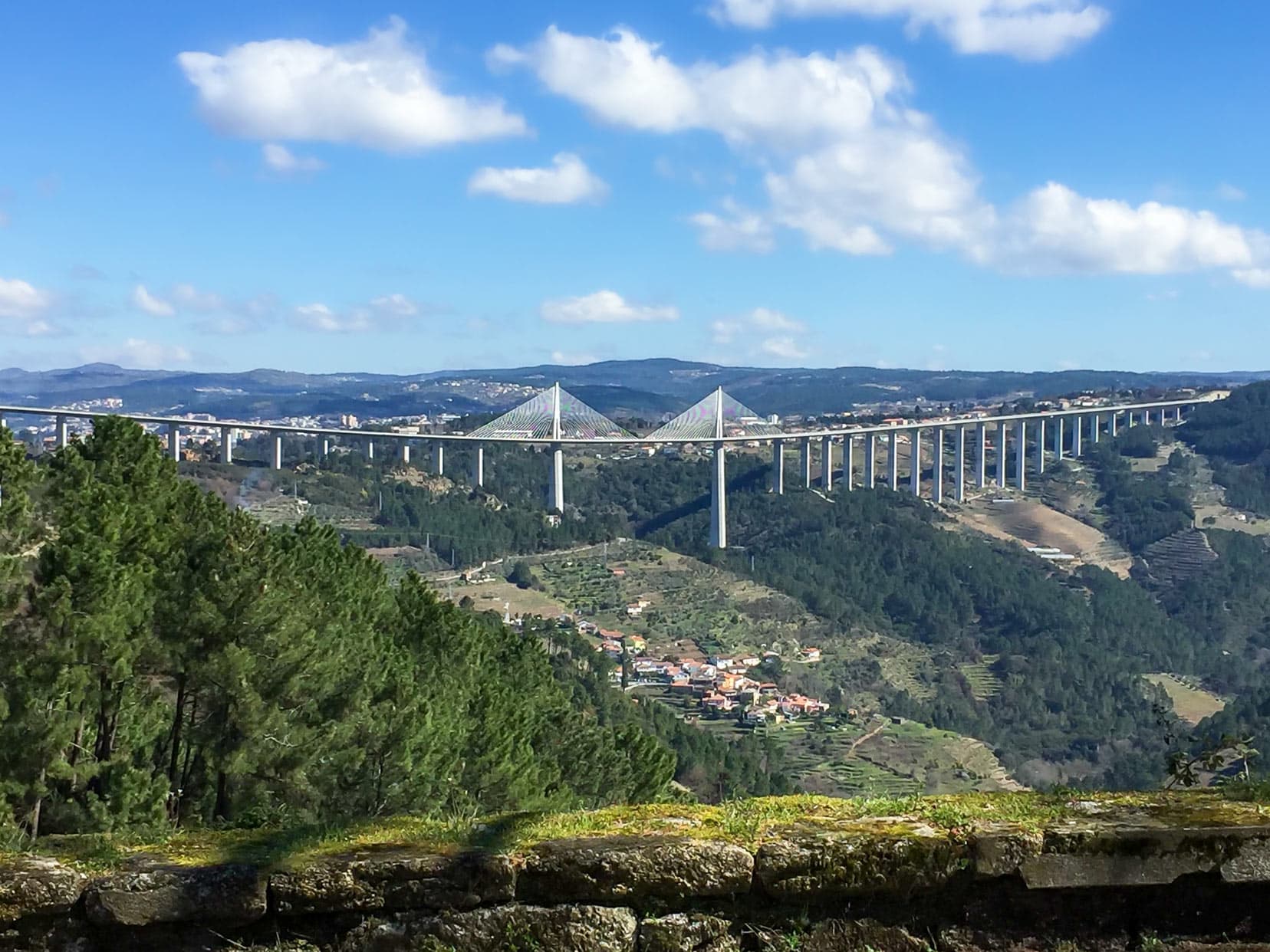
Driving to Portugal in a Motorhome
If you drive to Portugal in a motorhome or campervan, you will be arriving from Spain, as there are no direct ferry routes to Portugal.
If your campervanning trip starts in the UK and you are looking for the best motorhome route to Portugal, you have a choice of options. Obviously, all include crossing the Channel first.
Brittany Ferries runs two routes to Spain. From Plymouth to Santander (20 hours) and from Portsmouth to Santander or Bilbao (24 hours).
Alternatively, you could take a ferry or use the Euro tunnel to France and then drive through France and Spain to Portugal.
You can get a quote from Ferries Direct here.
We began our Portugal trip by arriving in the Algarve from Southern Spain. Our route then took us north through Portugal before we headed back into Spain. This was part of our larger Europe motorhome trip, which we began in Germany.
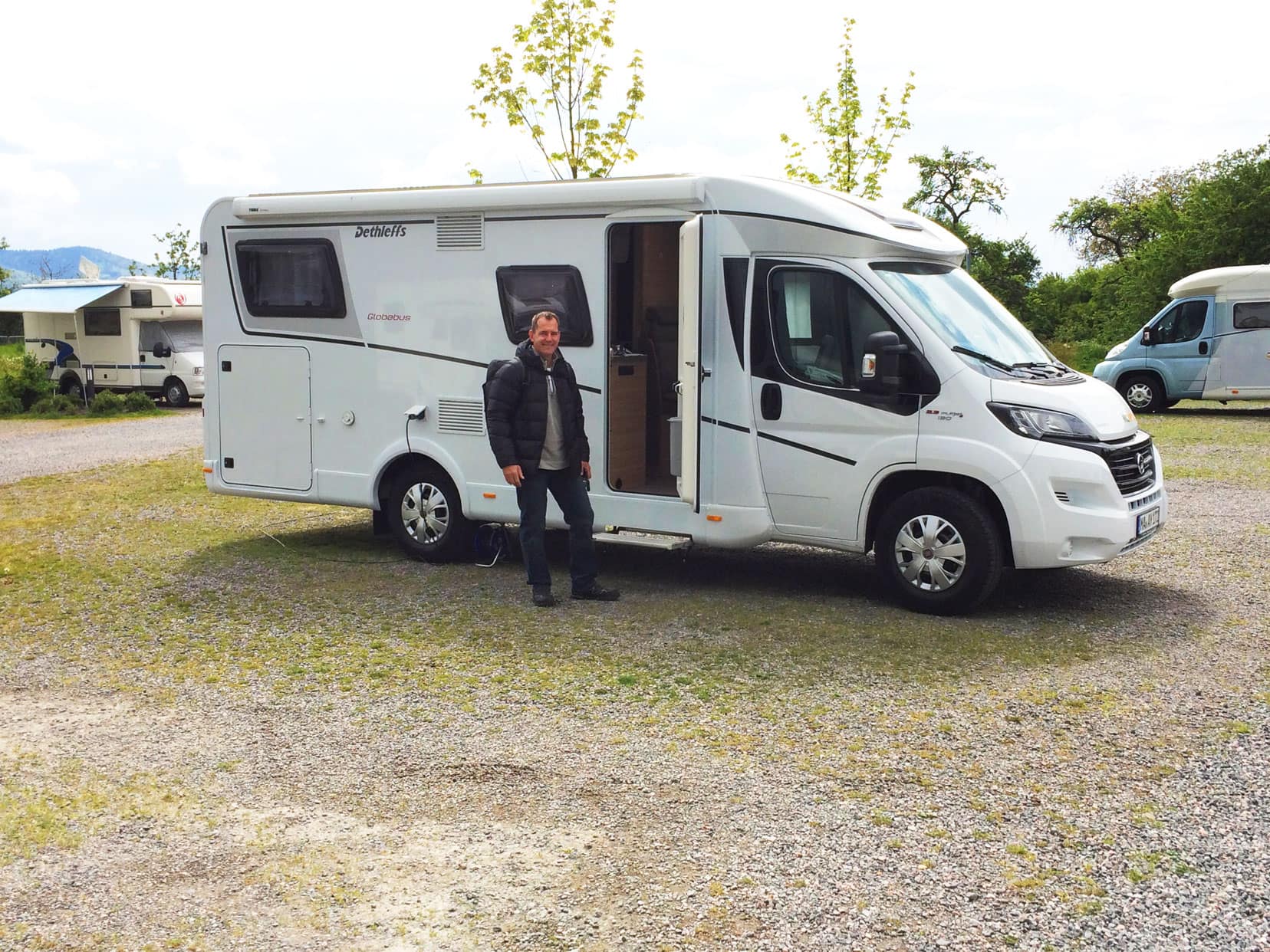
Driving Tips For Your Portugal Motorhome Trip
These essential driving tips will help you navigate your campervanning adventure in Portugal with ease. They cover everything from toll navigation to local road rules, ensuring a stress-free experience.
- Driving Side: In Portugal, drive on the right and overtake on the left.
- Seatbelts: Compulsory for all passengers.
- Essential Documents: Carry your driver’s licence, vehicle insurance, registration document, and passport.
- Vehicle Requirements: Equip your vehicle with a reflective vest and headlamp beam deflectors. ❗️Note: Dashcams are illegal in Portugal.
- Speed Limits: 120 km/h on motorways, 90-100 km/h outside built-up areas, and 50 km/h in urban areas.
- Vehicle Size Restrictions: Maximum length 18.75 metres, height 4 metres, and width 2.55 metres for campervans and motorhomes.
- Tunnels: Use dipped headlights in all tunnels.
- Tolls: Motorways have tolls. Consider an EasyToll pass or a Via Verde device for longer stays. Learn more about Portugal’s toll roads.
- Emergency Number: 112
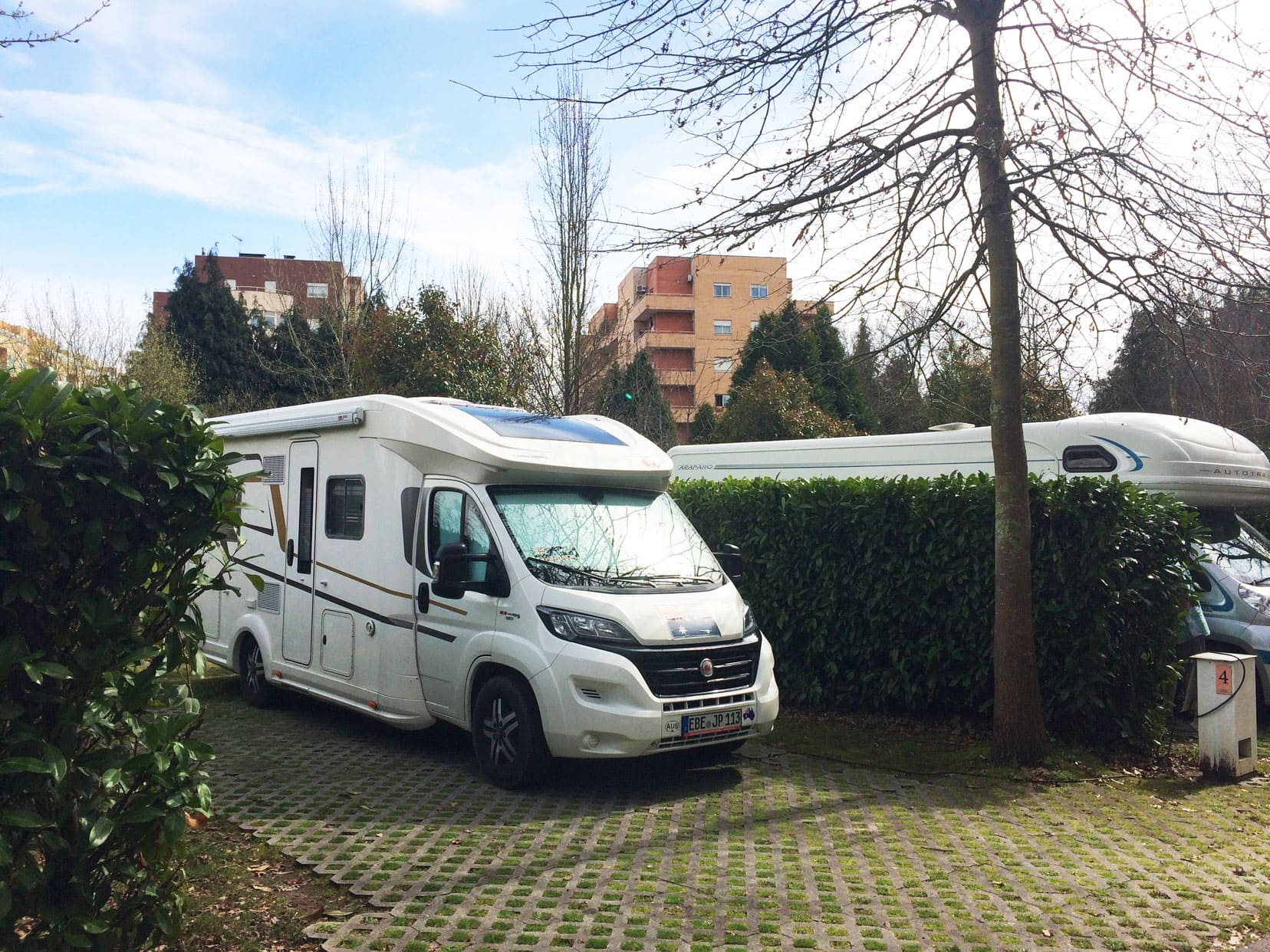
Enhancing Your Road Trip Experience
While practical planning is essential, the joy of the journey, especially for couples, cannot be overstated. Our experiences have led to valuable lessons for enriching road trips with your partner.
🔎Discover our secrets for harmonious travel in our Travelling as a Couple Guide.
Motorhome and Campervanning in Portugal… That’s a Wrap
We’ve created this guide as a go-to resource for motorhome travel in Portugal and hope it will help you plan your own Portugal road trip. If you’re ready to explore more, here are our best Europe road trip routes we’ve travelled.
Do you have any questions or additional tips for fellow campervan enthusiasts? We’re all ears!
Share your favourite Portuguese destinations and stories with us—get in touch here or comment below.
And don’t forget, before you set off, grab our FREE Road Trip Planner to make your journey even smoother!
Pin and save for Later
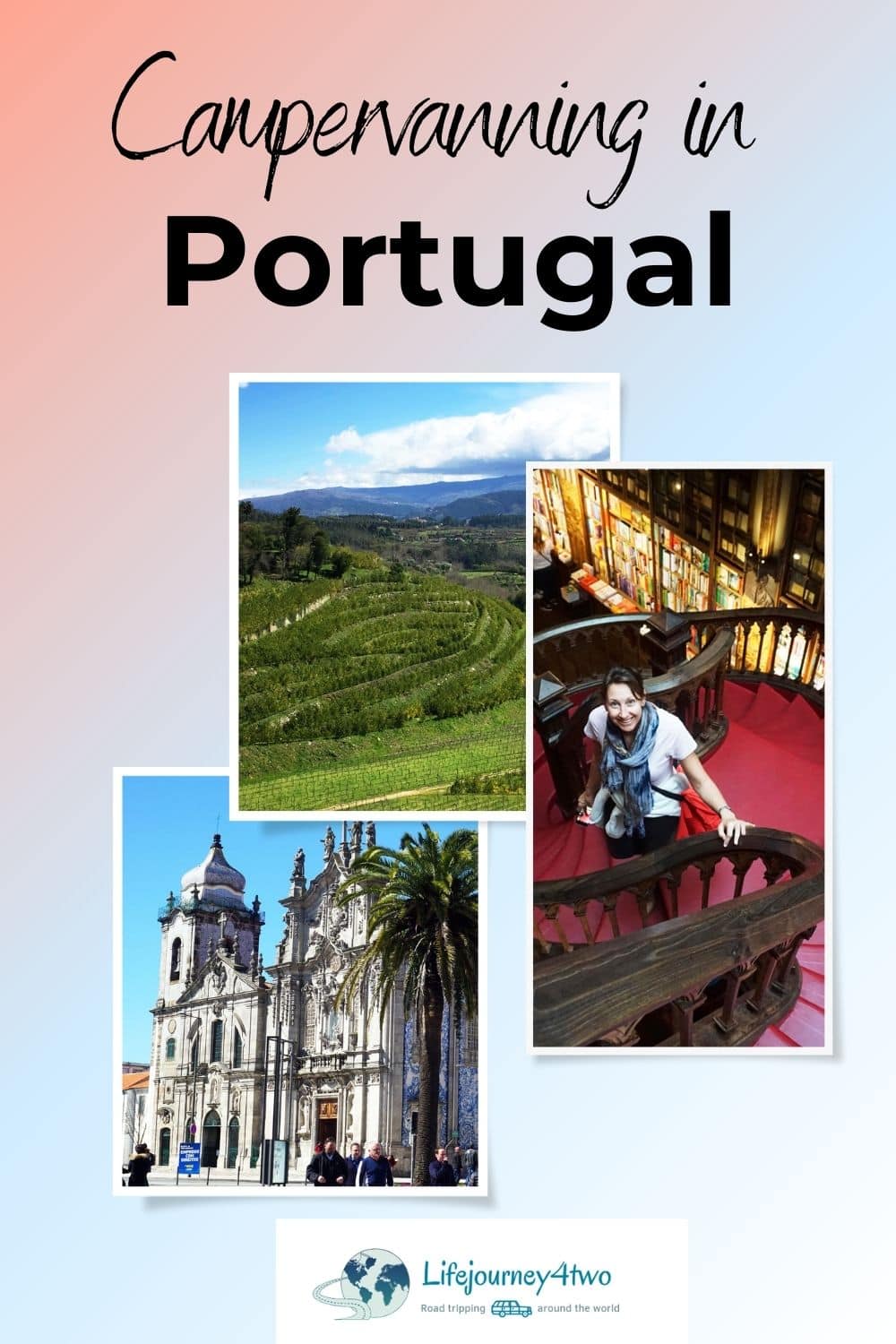
READ MORE:
- France: Motorhoming in France: Your Ultimate Guide
- Spain: Spain Road Trip: Sensational Places and Itineraries
- Greece: Campervan Greece Road Trip
Planning Your Travels?
These are the travel resources we recommend and use when planning our trips.
- 🚘 Car Hire: We use DiscoverCars.com
- Motorhome/Campervan Rental: We highly recommend the Motorhome Republic
- 🪪 Order your International Driver’s Licence online here
- 🛏 Book Accommodation: We use Booking.com to find accommodation that suits our budget
- 🐶 Pet Sitting/Pet Sitters: Check Out TrustedHousesitters here (Use our Discount code: LIFEJOURNEY25 for 25% off. )
- Activities and Experiences: Get Your Guide and Viator
- Travel Insurance: Safetywing or World Nomads
- 🥾 Travel Gear and Accessories: Check out our top picks here — Lifejourney4two page on Amazon
For a more thorough list, visit our Travel Resources page here.

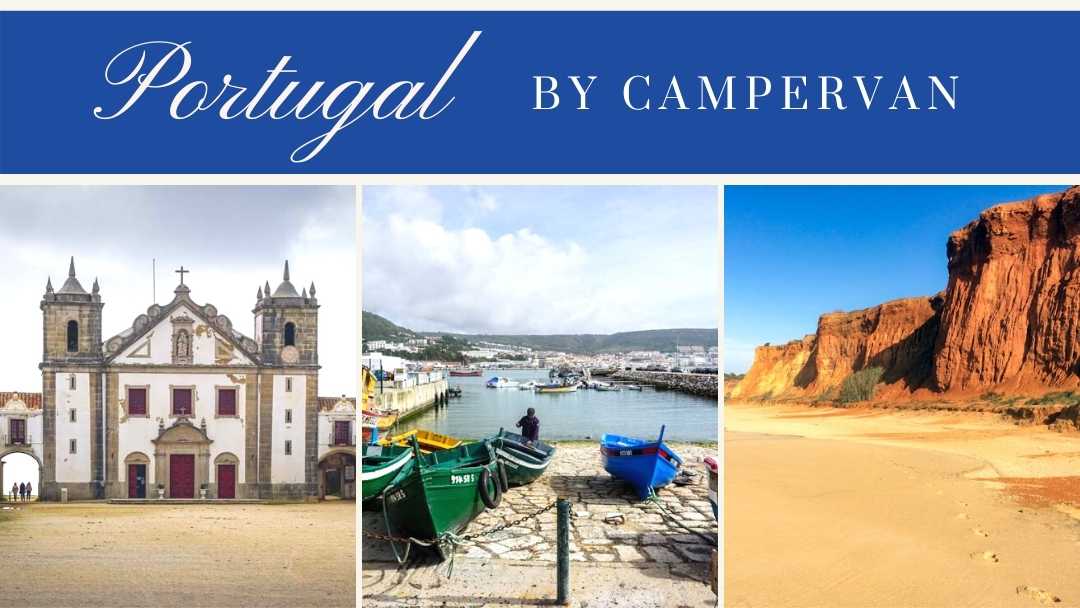

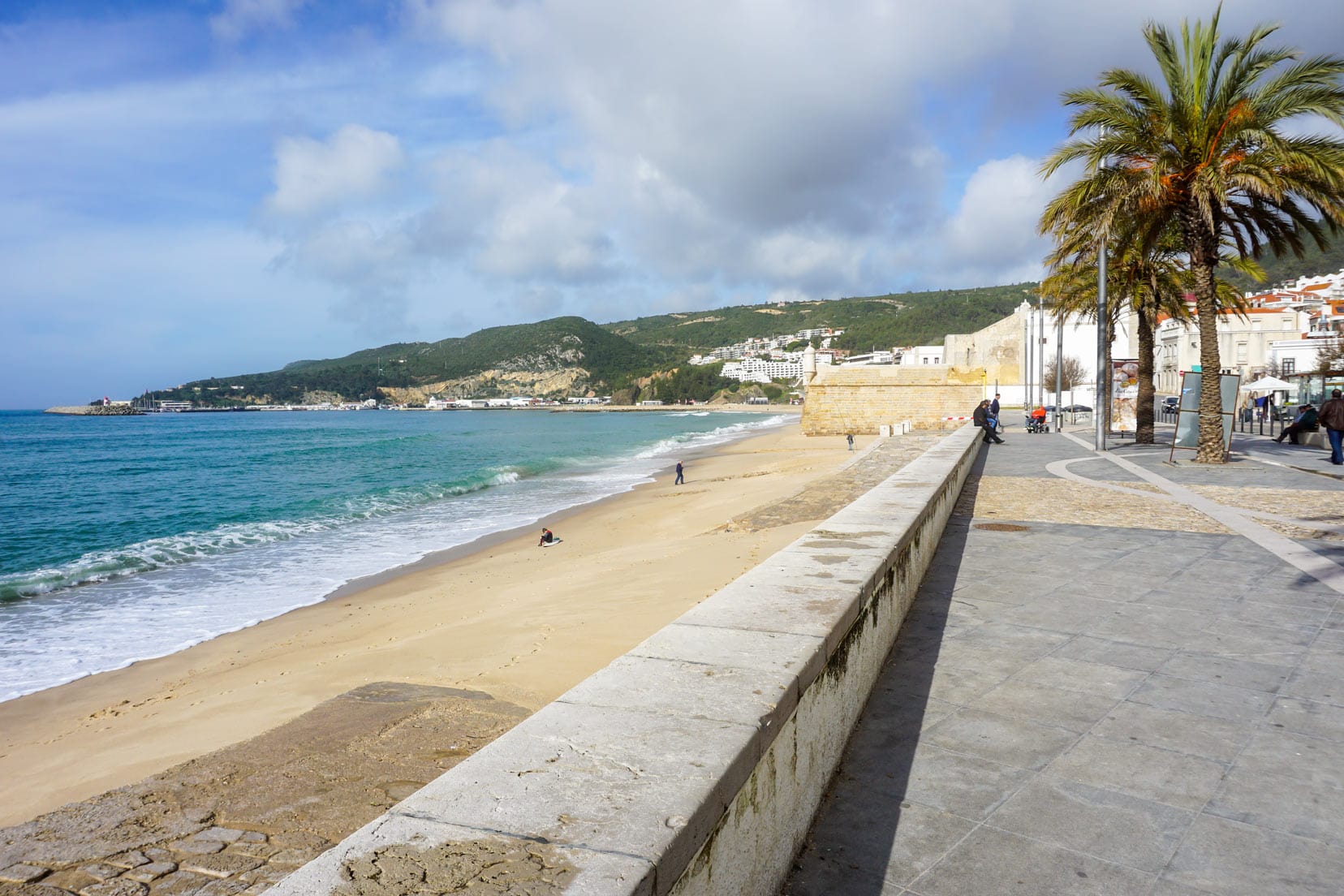
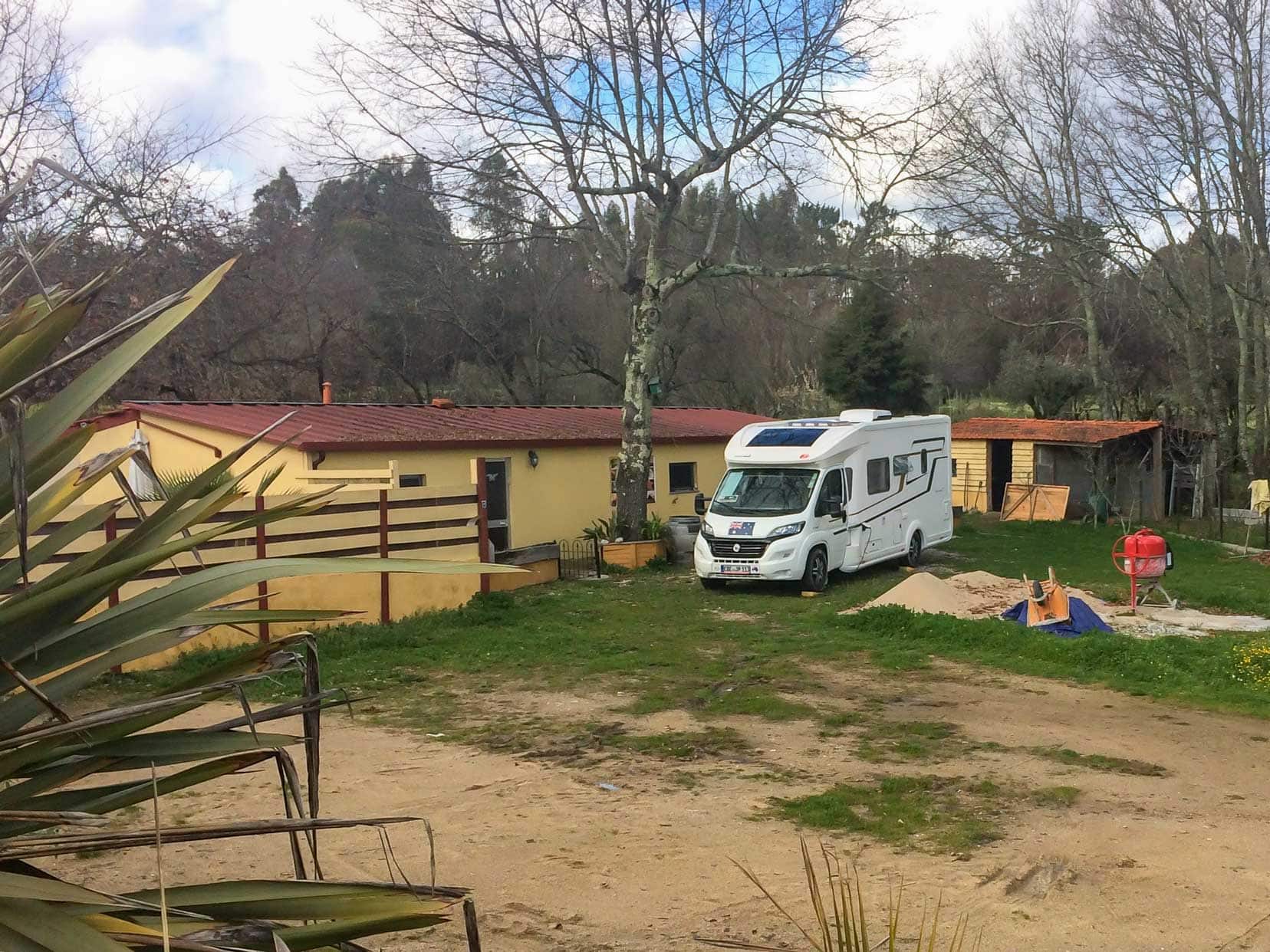
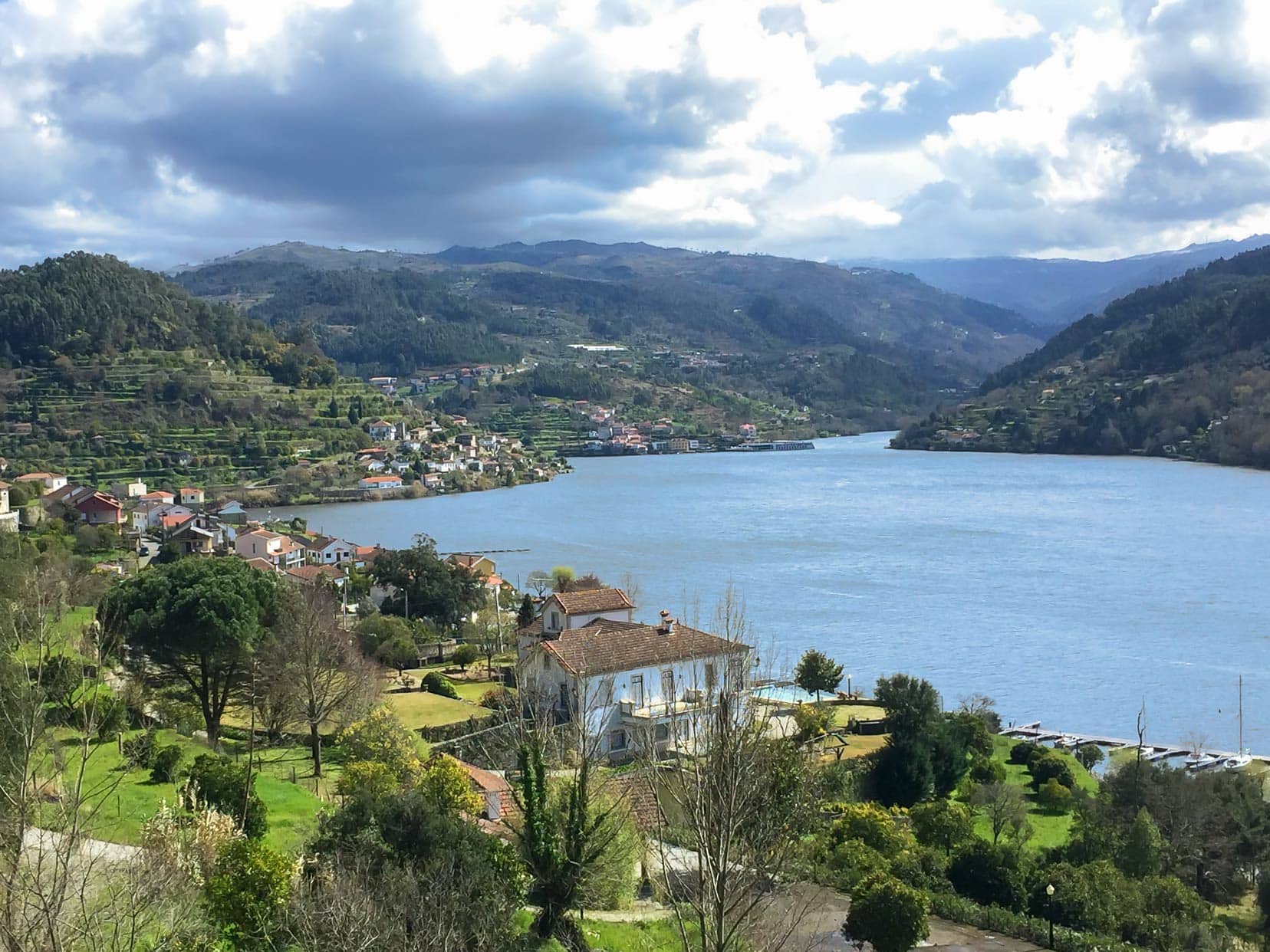
Hi this looks amazing, maybe I missed it, but what was your average expenses for this trip?
Hi there, yes, the motorhome trip through Portugal was great. We didn’t do an individual breakdown of costs for Portugal but for our average expenses etc. in Europe you can find a breakdown in our campervanning in Europe post here.